

How to Get An Article Published in a Magazine in 5 Easy Steps
by Mel Beasley | Oct 31, 2022 | Publishing
If you’re serious about making writing your career, knowing how to get published in a magazine is key to building a solid portfolio so that you can land quality writing gigs or a high-paying writing job. If your end goal is to eventually write books, having published work in magazines can also reveal a level of sincerity to literary agents that otherwise wouldn’t.
Why You Should Submit to Magazines
Getting published in a magazine will not only boost your confidence as a writer as you work toward your long-term writing goals, but it will also build your online presence as a writer and author. Here are just a few reasons you should pursue getting published in a magazine.
It Builds Your Online Presence
Building your audience as a writer doesn’t happen overnight. Even with a bestselling book, there’s often a great deal of marketing and press that happens before an audience is built and a book even gets close to the bestseller list. Not every publishing company will have the funding to push your book as hard as larger houses, so it’s best to play it safe and start marketing yourself as a writer or an author as soon as possible. Publishing short pieces in magazines will not only get your name floating across the internet, but it will hopefully encourage readers to find you on social media so you can market to them further later on.
[et_bloom_inline optin_id=optin_2]
Published Work Leads to Writing Jobs
If you’re looking to work for a publication in the future, or you’d like to write for a company, your college essays won’t work as writing samples. However, getting published in a magazine adds credibility to you as a writer. A published article means you are talented and professional enough to make it past at least one editor, which instills confidence in employers that you can handle a writing position. Additionally, published pieces also indicate a level of passion and seriousness that unpublished work just can’t match because it takes time, editing, and research to get published.
It Makes Your Query Letter Stand Out
While it’s not impossible to get a book published without having previously published work, it most certainly helps add credibility to your query letter. When submitting your book idea to a literary agent, you’ll need to attach a query letter that provides a bit of information about you, and a summary of your book. You’ll also send something similar to magazine publications during the submission process. Agents and editors certainly take experience into account when considering pieces to publish, and that experience paired with the level of writing you’ve attached will certainly work hand-in-hand when they are deciding to publish your writing.
Getting Published in a Magazine Boosts Confidence
Getting published in magazines will boost your confidence as a writer. Let’s be real. Getting a book published is a long, arduous process. Not only does it take months and sometimes years to write a novel or a book, but landing an agent for it can take just as long. Even if you’ve landed an agent, you still have to wait until they’re able to find the right publisher for it. And, even after all that waiting, you still have to wait at least a year to two years before your book will finally hit the shelves. It’s extremely discouraging to receive rejection letters for your book, and it can feel impossible to get your book published when the end of the tunnel is so far off.
Getting shorter pieces published periodically as you work on longer projects will help keep you motivated and encouraged as a writer. Plus, you’ll most likely make some great contacts by interacting with editors, and potentially other writers who have been published in the same magazine. You’ll also most certainly learn a thing or two about editing your work based on the feedback you receive from magazine editors, which will only reflect positively on your other writing projects.
Getting published in a magazine will help solidify that you’re heading in the right direction with a career in writing. It will give you a sense of dignity and pride in your work, pushing you to get better and keep writing. Not only that, but it will give you evidence that you are who you say you are, a writer inside and out.
Publication in a Magazine Makes You a Better Writer
The submission and publishing process for magazines will help get you acclimated to the process as you prepare to dive into the book publishing world. It will teach you how to handle the submission process, query letters, and how to take rejection letters in stride. You’ll learn how to professionally communicate with editors, how to receive feedback, and how to translate an editor’s feedback into your writing so that it improves it overall. Every editor is different. Some editors are gentle and encouraging with their feedback, while others are more stern and blunt. You’ll learn how to not take feedback personally, and how to have a successful, professional relationship with both easygoing and difficult editors alike.
Steps to Getting Published in a Magazine
Submitting your writing to a literary magazine or any other kind of magazine isn’t as hard as it might seem. In fact, only a few simple steps stand between you and magazine publication, and the hardest one is writing the content. Check out the steps below.
- Write a Solid Article: You don’t necessarily have to have a finished article before choosing the magazine you want to submit to. It’s sometimes good to have an idea of the publications you’d like to be published in beforehand so that you know what they prefer to publish. Once you have an idea of what kind of essay or article you want to write, you’ll need to get it on paper and make sure you polish it up as much as possible. Write something you have adequate knowledge about rather than something you simply researched and regurgitated. Have a writer friend review the essay or article for you and provide feedback. Revise the piece until it’s as polished as possible.
- Find the right fit for your essay or article: When you’re ready to submit your finished article, don’t just submit it to every magazine possible. Do some research to find the best possible fit for your piece of writing. For example, if you’ve written a flash nonfiction piece, you should research literary magazines that frequently publish that kind of content. Spend some time reading their content to ensure your essay makes sense. No one likes a rejection letter, so don’t increase your odds of getting rejected by submitting to places that would never be interested in your essay or article.
- Find the submission guidelines and follow them precisely: If a publication is accepting submissions from the public, you’ll usually find a submissions page in the footer of their website or the main navigation. If you can’t find the submission page in the navigation or footer, try typing the name of the publication in Google along with the word “submission.” Don’t submit to magazines if they aren’t open for submissions. This will only annoy editors and possibly ruin your chances with them in the future. Once you find the submissions page, you should see information about that magazine’s submission guidelines. These guidelines will usually tell you what kind of content they are currently looking for, as well as the formatting instructions. Be sure to read and reread the instructions carefully, and follow the guidelines exactly. Failure to follow the submission guidelines could automatically withdraw your chances of acceptance. Plus, it’s annoying. Whether the magazine is asking for a specific email subject line, or that you send your document in a particular file format, do exactly that and you should be fine.
- Write a mini query letter: If you’re not familiar with query letters, this is a brief message that you’ll send along with your essay or article. Unlike book query letters, which tend to be on the longer, more detailed side, magazine query letters are a bit different. First, keep your query letter formal and brief. You’ll most likely be sending your letter as an email with your article as an attachment, so it should be short enough that your reader won’t have to scroll to finish reading it. You should say hello and use the name of one of the editors if you know it. You can find a list of staff for the magazine on the About page on most magazine websites. Next, briefly let the editor know what kind of content you’re submitting, and include a 150-word bio of yourself as a writer. It’s also a good idea to mention at least one article you’ve read from the magazine and explain why you feel your piece would make a good fit for publication as well. You won’t need to add a synopsis of your short story, essay, or article. It’s already short, so they won’t have any trouble breezing through and figuring it out on their own.
- Use writing submission websites: There are tons of writing submission websites out there that list all the open calls for submissions from publications all over the world. If you’re not the kind of person who reads a lot of magazines, or who enjoys doing a lot of research online, it might be easier to hop on one of these websites to find open calls for submissions.
- Submittable : This is one of the best places to seek out open calls for submissions as well as writing contests. Using this platform is free. You can create an account, fill out your profile, and then search for open submissions after that. You can submit through this platform and track your submissions as well.
- Poets & Writers : This is a great website to not only read about writing and read other people’s writing but also to submit your work. Here you can find information on literary agents, writing workshops, groups, and so much more. Not only will you discover open calls for submissions, but you can also find open writing contests that often come with cash prizes for winners.
- New Pages : This website looks very similar to traditional classifieds and provides an ongoing list of calls for submissions, information on literary events and writing workshops, and has an extensive list of literary magazines.
If you’re interested in getting published sooner rather than later, consider submitting to magazines. Getting published will not only boost your confidence as a writer, but it will also help you build your writing portfolio and online presence. Good luck out there!

Mel Beasley has a bachelor’s in creative writing and journalism from the University of North Carolina at Wilmington. He brings 9+ years of digital marketing and writing experience to the table by writing for publications such as Lumina News and Encore Magazine. He spent 2 years as a college-level writing tutor, and is a certified writing tutor through the CRLA, which is a prestigious cert recognized by the Association for the Coaching & Tutoring Profession. He is a professional SEO blogger with experience writing for brands such as Boardworks Education and The Greater Wilmington Business Journal. One of his latest website and marketing projects has been building the website for the now New York Times Bestselling author, Nina de Gramont .

7 Tips for Setting Achievable Writing Goals – 2024
Mel Beasley Dec 21, 2023

5 Reasons a Creative Writing Degree is Worth It
Conner DiGiacomo Jul 28, 2023

The 5 Stages of Freytag’s Pyramid (Plus Examples)
Conner DiGiacomo Jul 15, 2023
Latest Articles

7 Unexpected Things You’ll Learn At Writing Workshops
Conner DiGiacomo Jul 8, 2023

Subscribe for Updates, Writing Tips, and More!
Thanks for subscribing we'll send you a confirmation shortly..., pin it on pinterest.
- Print Friendly
- Writing Courses Online
- Course Testimonials
latest posts

How to Improve Your Writing in Three Easy Steps

Verbeter Jou Kans Om ʼn Kortverhaal Kompetisie Te Wen Só

Topics to Write About: How to Choose

Free Writing Competition – My Writing Journey

Logical Flow: The Key to Compelling Writing

Can You Make a Living From Travel Writing? We Ask Travel Writer Gabi Logan

Four Habits of Successful Writers

Famous Quotes on Writing

Freelance Magazine Writing: 10 Tips For Beginner Journalists

Are you interested in freelance magazine writing? Here are 10 trade secrets to help you get your name in the byline.
By nichola meyer.

1. How do I submit my first magazine article?
As a beginner in the field of freelance magazine writing, you have two main options.
“On spec”: The first method is to write the article, and then e-mail the piece with a cover letter to the features editor of a magazine. You can find his or her details on the masthead page in a magazine where the staff members are listed.
When you send a completed article, it’s known as “submitting on speculation” (or “on spec”). This method works well if you’re a novice writer and need a foot in the door with a magazine.
The editor can immediately assess the quality of your writing and if it will fit with the style and tone of the magazine.
Remember, you will need to study the magazine carefully before you even start writing. Requesting the magazine style guide from the features editor is another way to tune in to the type of reader the magazine is targeting.
“Querying or pitching”: The other option is to pitch your idea straight to the features editor in a query letter, and see if the editor is interested in your proposed article.
If the features editor likes your idea and gives you the go-ahead to write the article, then you simply need to deliver the piece to deadline . This method works well if you’ve written for the magazine before, and the editor trusts that you will produce what you have promised in your query letter.
2. What makes for a good magazine journalist?
Surprisingly, good journalism is not just about fine writing skills. Editors emphasise these five key habits of their star journalists:
1. Their writing captures the unique tone, style and content of the magazine – and fits with the needs of the target reader. 2. They can stick to deadlines. 3. Their facts are accurate; their research is sound and thorough. 4. Their work is not “shoddy” – meaning that spelling, grammar and punctuation are correct, and sentences are carefully crafted. 5. They behave professionally, from their well-written cover letter to their invoice.
3. How much money can I make in freelance magazine writing?
Regardless of how many years you’ve worked in the industry, your income as a freelancer depends entirely on how hard you’re willing to work, how well you can write, the thoroughness of your research and your general professionalism when dealing with the publishing houses.
Rates vary depending on the country and the magazine’s circulation. Best is to find out the rate by phoning the magazine and speaking to the features editor. Here are some rough guidelines.
Most often you are paid per word. The recommended going rate for beginner journalists is 60 c per word in New Zealand and Australia (70 p per word in the UK, and R2.00 upwards per word in South Africa). Specialist writers can get double that amount per word. Per month:
Considering that most features are 1500 words in length (2200 words at most), do your sums to work out your income per article. And then, remember, you’d still need to pay up to 25 % tax on that income.
Seasoned journalists write about 13 pieces per month (this can include columns, advertorials and other business writing).
4. When do I get paid for articles?
Some publishing houses pay upon publication, i.e. the month-end following when your article appeared in the magazine. But what few know is that magazines work 6 to 12 months in advance, so the fee for the piece you sell today could only appear in your bank account a year later!
A few publishing houses pay upon acceptance of your piece, which means roughly one month after acceptance.
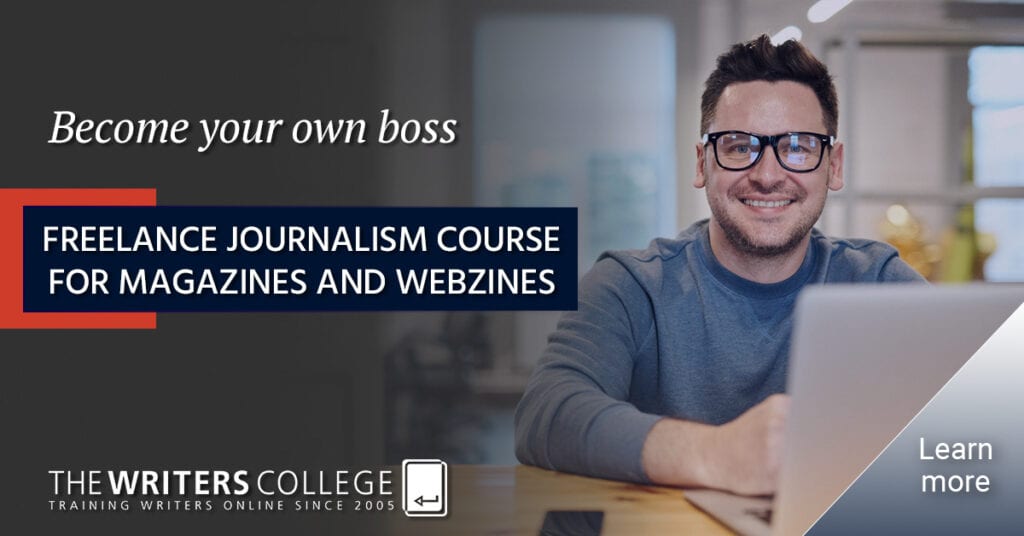
5. How do I get paid for articles?
As a freelance journalist, you are in charge of your own “small business”. You are responsible for invoicing the publishing houses.
The features editor will let you know when you need to e-mail your invoice – either upon acceptance, or upon publication of your article to the accounts department. You are usually paid by electronic transfer directly into your bank account.
6. How much scope is there for work in freelance magazine writing?
There are hundreds of publications and speciality publications looking for freelance contributions. Apart from shelves loaded with consumer magazines, there are trade magazines and inflight magazines that offer outlets for freelancers, although they may pay slightly less per word.
Furthermore, we have thousands of reputable webzines and paying blogs online. Many of these publications don’t pay for writing, but for those that do, you generally get paid a flat fee for a 300- to 500-word article.
7. How do I get commissioned to write an article?
Once an editor knows you and likes your work, it won’t be long before you receive your first commission.
What is a commission? It’s when the editor asks you to write a piece on a particular topic, and gives you a brief to follow. You need to follow the specifications in the brief – and deliver to deadline. It’s easier to work this way, rather than go through the more work-intensive process of querying or writing on spec, but you first need to build a good relationship with the editor.
8. What skills are essential for success in freelance magazine writing?
Apart from the essential skills already mentioned under question 2 above, you will also need:
- Networking ability (just like in any business!). The more editors you know – the more commissions you’re likely to land.
- Integrity: plagiarism and faulty research are likely to spell the end of your career
- Determination: One magazine’s “No” can be another’s “Yes”. Keep trying, keep writing.

9. What happens if a magazine doesn’t want to publish one of my articles?
This can happen to the best of writers! The magazine may have recently published something on the topic you’ve covered, or the article simply doesn’t fit the style of the magazine. In those cases (and you can politely ask a features editor why they’ve declined to buy your piece), you can send it on to another magazine for possible publication.
However, sometimes articles are simply not up to standard. In that case, you need to rewrite and edit, before you can try selling it again.
10. What legal rights and support do I have as a writer?
As the writer, you retain copyright over your piece, as long as you don’t sign away “All Rights” in a contract with the publisher. This means that a magazine has no legal right to re-sell your piece in any form or format, without paying you again for the re-sale. Every country has writers’ guilds or groups of writers that can support you. All freelancers are highly advised to join one of these guilds, not just for invaluable advice, but also ongoing support from other journalists.
About the Author

Nichola Meyer has been the principal of The Writers College ( SA Writers College , NZ Writers College and UK Writers College ) for the past 15 years.
With a background in lecturing at secondary and tertiary colleges, she taught magazine journalism for several years. She was also a journalist specialising in parenting and women’s issues for several magazines, including O, The Oprah Magazine , Femina, Child Magazine and Baby & Me .
you might also like

LESS HUSTLE, MORE FOCUS
Get fresh industry insights related to personal entrepreneurship, commerce, and technology from a professional journalist and marketing consultancy owner.
Sign up for my Newsletter here

In This Post:
How to write an article for a magazine.
Pitching a magazine is a whole other beast. When you land a print placement, however, you'll score major credibility points as a writer or industry expert.
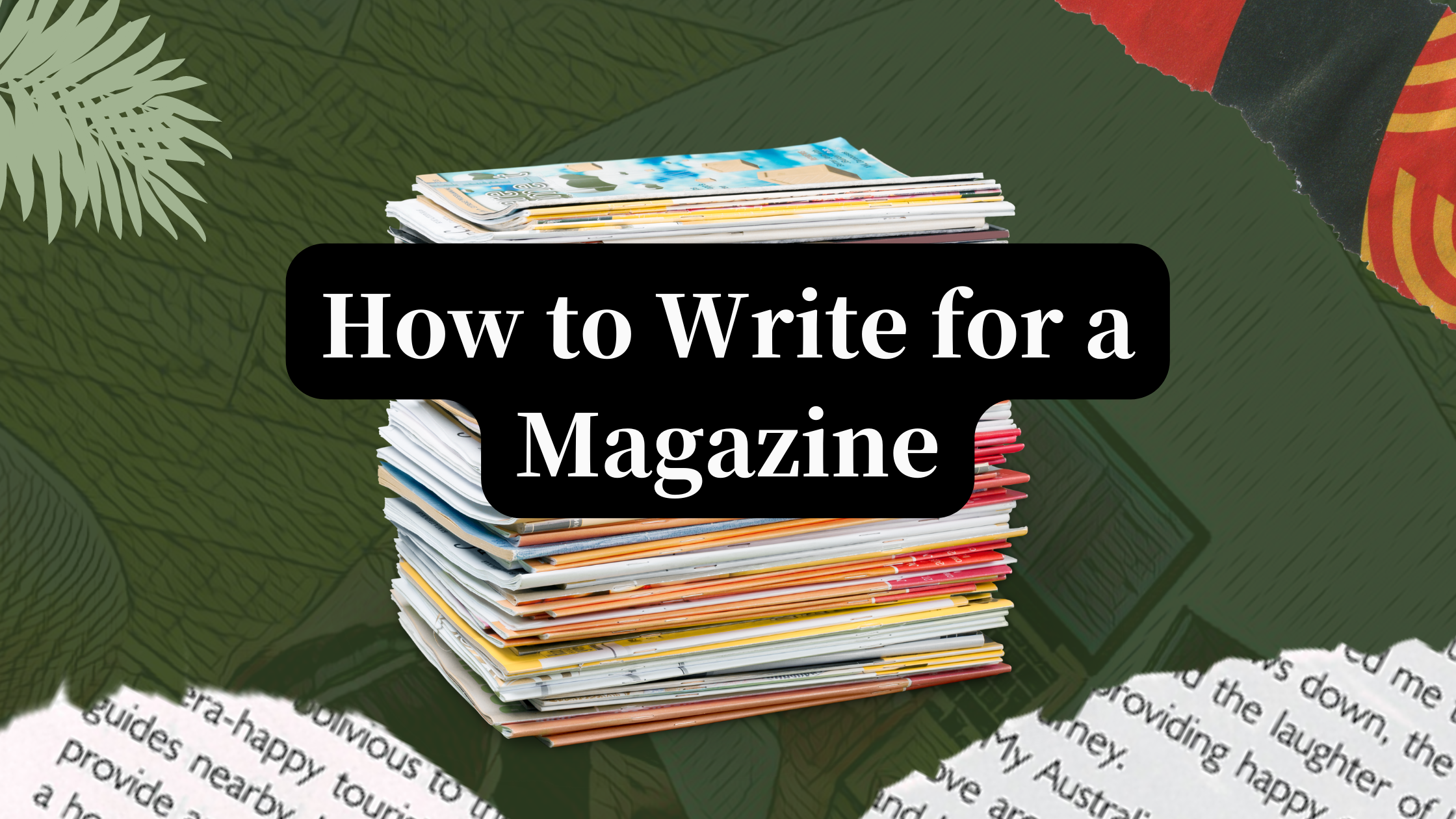
Writing an article for your local newspaper, trade magazines, or national magazines is simpler than you think. But simple doesn’t mean easy.
Freelance writers and industry leaders alike want to land a feature article in a print publication, because magazine writing projects authority and expertise. Media publications often reserve their print edition for the best magazine articles, and a features editor or managing editor will be highly selective with which freelance writers they tap for various article opportunities.
Key Takeaways
- Magazine and newspaper bylines are considered very reputable, since these publications have limited space.
- The timing of your pitch is important, as magazines are produced weeks or even months in advance.
- It's good to be on editors' radar, as they often are shuffling an issue up until the 11th hour, and may want to assign you a piece with quick turnaround to fill a hole.
It’s not just the high quality of the article that makes print pitching different. In magazine journalism , brands often put their issues together months in advance to ensure they’re printed, shipped, and sold on schedule.
In addition to pitching a good magazine article, you also need to send your query letter at the right time in the magazine production process before you start writing. Newspaper articles don’t require as long of a lead time. It all depends on the publication’s submission guidelines.
Related: How to Pitch an Article: 72 Outlet How-Tos
If you’d love to one day write an opinion article, pen a personal essay, or just get more freelance writing jobs with popular magazines, here is what to keep in mind in magazine writing.
Writing for Magazines: A Coveted Byline
Before the internet, media was mainly delivered through print journalism. A freelance writer or aspiring magazine writer would send a query letter to the editor, and magazine editors would decide which magazine articles to pursue, based not only on the article ideas themselves, but also how well they balance one another, based on personal experience.
In print, there is a finite amount of space on the page. In contrast, websites can publish all the articles — they just create a new URL for every article — so the constraint is editor and writer labor, not lack of space or word count. Article placement in a magazine has greater merit and is considered more valuable, even if it’s a local magazine.
Important : It can be tough to pitch a big feature story right out of the gate. Consider pitching a smaller story in the 700-1,200 word range first to build rapport with an editor.
Many of today’s magazines have been around for decades, if not longer, and they’ve built up a track record for editorial quality and influence. We assume that, if someone has written for a reputable magazine or national publications for a particular topic, they are a skilled freelance writer.
In our digital age, many of the most established brands continue to publish a physical magazine, even if the magazine’s readership has declined, because it cements their status as an influential publication. Often, if you write a magazine article, it will also be used online.
This was the case for me when writing an article for OUT magazine. My entire article was accepted, and received a two-page spread in the mag, but it was also published as a post online.

Pro tip: acquire physical copies of your placements so you can document them and use them online, ethically.
How to Pitch a Magazine in 3 Steps
Pitching a physical magazine is similar to other pitching efforts. The single most important factor to a winning pitch is that it’s relevant to the magazine’s target audience. The following three steps will help you ensure your pitch is on point every time; even if your pitch isn’t accepted, editors keep an eye on staff writers and other writers who consistently send relevant pitches, and eventually you will see progress.
Step 1: Research Current and Upcoming Magazine Topics
Read the magazine! What you think a magazine covers based on what you read ten years ago may not be what the outlet covers at all anymore. Browse both the publication’s website and the physical magazine itself to get a sense of their writing and what the brand is currently covering. Look at the news articles and writing styles.
Additionally, for physical magazines, it’s worth your time to poke around online for either a media kit or an editorial calendar . These kits are sales PDFs a magazine makes publicly available to attract prospective advertisers. The kit comes out in the fall or winter each year for the upcoming year, and lists the planned theme of every issue. This can be helpful intel when pitching big publications.
To see what the online version of a brand has previously covered, you can do a web search on Google for that specific site. Start your search with “site:www.outletdomain.com”, then search a topic. In this example, I searched past coverage of Gen Z on Entrepreneur’s website.
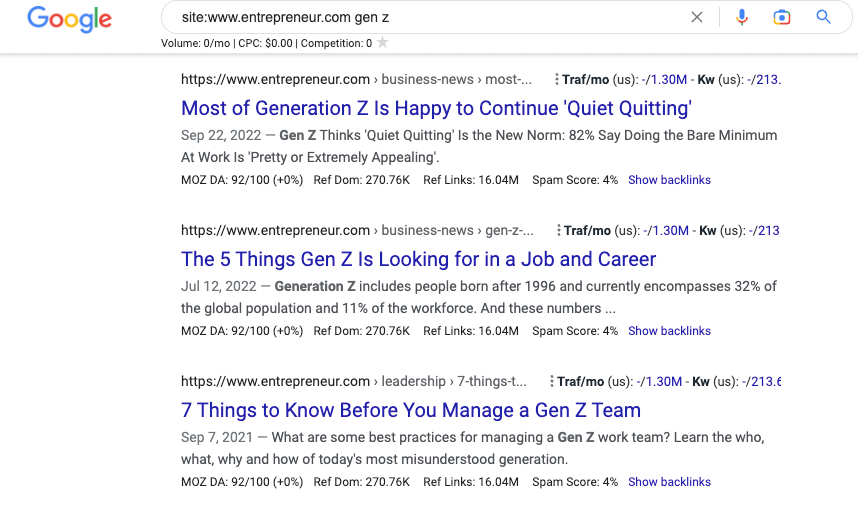
The "site:" command in a Google search query will let you filter search results to a particular website.
Knowing an outlet will help you tailor your article pitch to fit the voice, style, and format of the target publication.
Step 2: To Locate Gatekeepers, Find a Masthead
Now comes the tricky part: pitching the editor or decision-maker who oversees print coverage. Luckily, most magazines’ editors and other personnel responsible for bringing a magazine to life will be credited in both the physical issue and online. This list is called a masthead.
A major magazine will engage many writers and other contractors to bring an issue to life, but the staff who are listed on the masthead are almost always directly involved in the production process. This is helpful research material.
For example, searching “Allure masthead” led me directly to their digital masthead page.
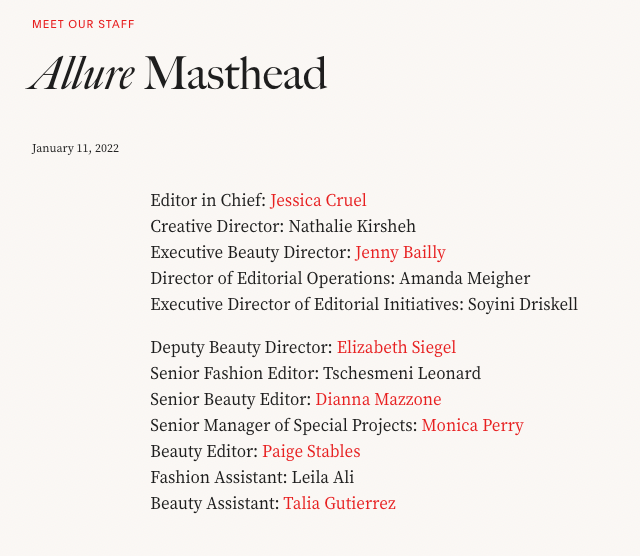
The Allure masthead. Screenshot captured November 1, 2022.
From the masthead, do some digging on where these different editors are hanging out outline. Are they on Twitter, LinkedIn, or Instagram? Are they writing articles for magazines as well? What stories are they currently publishing? Also track down their email address.
Step 3: Craft a Strong, Print-Specific Pitch
In print article pitching, every word needs to earn its way onto the page. Your article pitch should have a compelling idea and a fresh perspective; specify whether you want to be considered for print publication, online publication, or both.
Most PR pitches are templates, press releases, or cookie-cutter stock pitches. The key to getting momentum in an article pitch is to hook the editor or journalist in the first couple of sentences. Indicate that your article pitch is not a stock pitch, and make a case for why this article is a perfect fit for them.
Pitch Your Next Magazine Article Today
Article pitching can feel overwhelming at first, but at the end of the day, story ideas just like yours are what make it to newsstands and get read by millions. Remain pleasantly persistent, and eventually your pitching efforts will pay off.
Thanks For Reading 🙏🏼
Keep up the momentum with one or more of these next steps:
📣 Share this post with your network or a friend. Sharing helps spread the word, and posts are formatted to be both easy to read and easy to curate – you'll look savvy and informed.
📲 Hang out with me on another platform. I'm active on Medium, Instagram, and LinkedIn – if you're on any of those, say hello.
📬 Sign up for my free email list. This is where my best, most exclusive and most valuable content gets published. Use any of the signup boxes on the site.
🏕 Up your writing game: Camp Wordsmith® is a free online resources portal all about writing and media. Get instant access to resources and templates guaranteed to make your marketing hustle faster, better, easier, and more fun. Sign up for free here.
📊 Hire me for consulting. I provide 1-on-1 consultations through my company, Hefty Media Group. We're a certified diversity supplier with the National Gay & Lesbian Chamber of Commerce. Learn more here.

Welcome to the blog. Nick Wolny is a professional writer and editor based in Los Angeles.
Structure of a Magazine Article: The Full Guide

The complete guide to the structure of a magazine article offers an in-depth look at creating enthralling magazine pieces, keeping the structure of a magazine article in focus.
Table of Contents
This comprehensive resource emphasizes the importance of mastering key elements to captivate your audience and produce high-quality content that effectively showcases the structural aspects of a well-crafted magazine article.
Introduction to the Structure of a Magazine Article: Laying the Foundation
Instead of a standard article, a magazine editorial often presents the writer’s opinion on a particular subject or issue. Although the content may be subjective, the structure of a magazine editorial should still follow a coherent and logical pattern. This ensures readers can easily follow the author’s argument and find the piece enjoyable.
The structure of a magazine editorial generally consists of several key components, including an attention-grabbing headline, an engaging lead, a well-organized body, and a firm conclusion. Each element plays a vital role in capturing the reader’s interest and effectively conveying the message.
The headline should be succinct yet powerful enough to pique the reader’s curiosity. It sets the tone for the entire editorial and helps readers decide whether to engage with the content further. A captivating lead follows the headline, briefly introducing the topic and drawing the reader into the heart of the editorial.
The body of the magazine editorial is where the author develops their argument or opinion. It is essential to present the information logically and coherently, using clear headings and subheadings to guide the reader through the narrative. Including compelling evidence, anecdotes, or quotes can also strengthen the writer’s argument and keep the reader interested.
Finally, a firm conclusion should summarize the editorial, summarizing the key points and providing a clear call to action or a thought-provoking statement. This creates a lasting impact on the reader and promotes further engagement with the topic.
Understanding the structure of a magazine editorial is vital for creating impactful and engaging content. By mastering the art of crafting powerful headlines, captivating leads, coherent body text, and firm conclusions, you can establish the groundwork for a successful magazine article that resonates with your audience and leaves a lasting impression.
Structure of a Magazine Article: Crafting Engaging Headlines and Subheadings
The power of an engaging headline and well-crafted subheadings cannot be understated when it comes to the success of a magazine article. These elements are instrumental in capturing the reader’s attention and guiding them through the content, playing a significant role in the overall magazine structure.
An enticing headline is the first point of contact between the reader and the article, and it can either facilitate or hinder their decision to delve further into the content. It should be short, impactful, and thought-provoking, effectively conveying the article’s essence in just a few words. Writing a captivating headline involves striking a balance between being informative and intriguing while remaining true to the subject.
Subheadings, on the other hand, break up the body of the article into digestible sections, making it easier for the reader to navigate through the content. They provide a clear roadmap of the article’s main points, helping the reader understand the flow of ideas and the magazine structure. Compelling subheadings should be concise, informative, and engaging, enticing the reader to continue reading and ensuring they can quickly grasp the key points being discussed.
In addition to their practical purposes, headlines and subheadings also contribute to the overall visual appeal of a magazine article. They help create a sense of hierarchy and organization, essential for maintaining the reader’s interest and making the content more accessible. By using varying font sizes, styles, and formatting techniques, designers can further emphasize the importance of these elements and enhance the article’s overall aesthetic.
Engaging headlines and subheadings are crucial to the magazine structure, serving functional and aesthetic purposes. By mastering the art of crafting these essential elements, writers and designers can ensure their magazine articles capture the reader’s attention, provide a straightforward and accessible narrative, and, ultimately, leave a lasting impression.

Structure of a Magazine Article: How to Hook Your Readers from the Start
In magazine writing, the lead is crucial in captivating readers from the outset. Serving as the opening paragraph, it establishes the foundation for the remainder of the content and is a vital component in the structure of articles. A well-crafted lead piques the reader’s interest and encourages them to continue reading the entire piece.
The primary objective of a leader is to provide a glimpse into the central theme or argument of the article while leaving the reader wanting more. It should be engaging, concise, and informative, offering just enough information to entice the reader without giving away all the details. Striking the right balance between mystery and clarity is essential in creating a compelling lead that successfully hooks readers.
The structure of articles often varies depending on the subject matter and the target audience. Nevertheless, there are several tried-and-true approaches to crafting compelling leads. One such approach is the anecdotal lead, which opens with a captivating story or personal experience that sets the tone for the article. Another popular option is the question lead, which poses a thought-provoking inquiry that piques the reader’s curiosity and encourages them to read on in search of an answer.
Regardless of the chosen approach, keeping the lead concise and relevant to the article’s central theme is essential. Additionally, the lead should transition seamlessly into the body of the article, maintaining a logical flow that maintains the reader’s interest and involvement in the content.
Structure of a Magazine Article: Building a Compelling Narrative
In magazine writing, the body text forms the backbone of the article, providing the substance and depth required to convey the author’s message or argument effectively. Drawing inspiration from magazine editorial examples can help writers build a compelling narrative that keeps readers engaged and maintains their interest throughout the article.
One of the essential aspects of crafting a captivating body text is maintaining a clear and coherent structure. This can be achieved by using subheadings to break the content into smaller, digestible sections, making it easier for readers to follow the narrative and absorb the information presented. Magazine editorial examples often demonstrate how effective subheadings can guide the reader through the article, ensuring they can easily comprehend the key points and arguments.
Another critical aspect of constructing an engaging body text is to vary the sentence structure and maintain a natural, conversational tone. This helps the content feel more approachable and enjoyable to read, as opposed to overly formal or rigid. Examining magazine editorial examples can provide valuable insights into how experienced writers maintain a consistent voice and style throughout their articles, fostering a connection with the reader and making the content more relatable.
Furthermore, using compelling evidence, anecdotes, quotes, or statistics can significantly enhance the credibility and impact of the body text. These elements not only lend weight to the author’s arguments but also help to keep the reader’s interest piqued, encouraging them to continue reading and engage with the content more deeply.

Structure of a Magazine Article: Visual Elements and Their Role
In magazine publishing, visual elements play a vital role in enhancing the reader’s experience and contributing to the overall structure of an article. As the adage states, “A picture is worth a thousand words,” and this concept holds true when considering the structure of an article. Images, graphics, and other visual components can bring the written content to life, adding depth, context, and appeal to the magazine piece.
Functions of Visual Elements
One of the primary functions of visual elements in a magazine article is to break up large blocks of text, making the content more digestible and visually appealing. By incorporating relevant images or graphics throughout the article, writers and designers can create a more engaging and enjoyable reading experience for the audience. This not only makes the content more accessible but also helps to maintain the reader’s interest and attention.
Another essential function of visual elements is to provide additional context or information that may be difficult to convey through text alone. For example, data visualizations, such as charts or infographics , can effectively present complex information or statistics in a more easily understandable format. This enhances the reader’s comprehension of the subject matter and strengthens the overall impact of the article.
Furthermore, visual elements can also contribute to a magazine article’s overall aesthetic and design. By strategically using color, typography, and other design elements, designers can create a cohesive visual language that complements the written content and reflects the article’s theme or mood. This adds to the reader’s enjoyment and reinforces the magazine’s brand identity and style.
Understanding the structure of an article is complete by considering the role of visual elements. By incorporating relevant images, graphics, and design elements, writers and designers can create a more engaging and visually appealing magazine piece that captures the reader’s attention and enhances their overall experience.
Structure of a Magazine Article: Crafting a Memorable Ending
A well-crafted conclusion is an essential component of any compelling magazine article. It reinforces the main points and ideas, leaving the reader with a lasting impression and closure. Understanding how to structure an article involves organizing the content logically and ensuring that the conclusion ties everything together, providing a strong and memorable finish.
When crafting a memorable ending, it is crucial to reiterate the key points discussed throughout the article, summarizing the central argument or message. However, this should be done concisely, avoiding repetition or regurgitation of information. Instead, the conclusion should offer a fresh perspective or insight that adds depth to the article and encourages readers to further reflect on the subject.
Another effective technique when considering how to structure an article is to end with a call to action, a thought-provoking question, or a prediction. This can inspire the reader to engage with the topic beyond the article, fostering a sense of curiosity and leaving them with something to ponder. The conclusion can impact the reader by provoking an emotional response or encouraging further exploration.
In addition, the tone of the conclusion should be consistent with the rest of the article, maintaining a sense of cohesion and harmony. Whether the article is informative, persuasive, or narrative-driven, the conclusion should reflect the same style and voice, ensuring a smooth and satisfying reading experience.
Mastering how to structure an article involves organizing the content effectively and crafting a powerful and memorable conclusion. By summarizing the key points, offering fresh insights, and provoking thought or action, writers can ensure that their magazine articles resonate with readers and leave a lasting impact. By incorporating these techniques, you can create a compelling, engaging magazine article that stands out.
What are the critical components of a magazine article structure?
The critical components of a magazine article structure include an attention-grabbing headline, an engaging lead, a well-organized body, and a firm conclusion.
How do I write a captivating headline for my magazine article?
A captivating headline should be short, impactful, and thought-provoking, conveying the article’s essence in just a few words. Strive to balance being informative and intriguing while remaining true to the subject.
What role do subheadings play in the structure of a magazine article?
Subheadings break up the body of the article into digestible sections, making it easier for the reader to navigate through the content. They provide a clear roadmap of the article’s main points, helping the reader understand the flow of ideas and the magazine structure.
How can I write an engaging lead for my magazine article?
To write an engaging lead, provide a glimpse into the central theme or argument of the article while leaving the reader wanting more. Keep it concise and relevant to the article’s theme, striking the right balance between mystery and clarity.
What are some tips for crafting a compelling body text?
Craft a compelling body text, maintain a clear and coherent structure, vary sentence structure, and maintain a natural, conversational tone. Use subheadings, compelling evidence, anecdotes, quotes, or statistics to enhance the credibility and impact of the content.

Learn How To Develop Launch-Ready Creative Products
Download How to Turn Your Creativity into a Product, a FREE starter kit.

Advertisement
Create a Memorable Social Media Experience
Get the content planner that makes social media 10x easier.

Invite Your Customers To A Whole New World
Create a unique user experience.

Maximize Your Brand and Make Your Mark
Custom brand assets will take you to new heights.

Faceless Affiliate Marketing: What You Need to Know

Faceless Marketing on Instagram: The Full Guide

Is Faceless Digital Marketing Just a Fad?

Neuromarketing: How to Use it in Business Strategies

Niche Markets: How to Create Products that Resonate

Faceless Marketing: How to Analyze the Psychology
The Definitive Guide to Publishing Digital Magazines
March 28, 2023.

Looking to publish a digital magazine?
Maybe you’re creating a digital edition for the very first time. Or, maybe you need to revamp your digital edition to make it easier to read. (If your readers have to pinch and zoom their way through your digital magazine, you’re not providing the best possible experience.)
This guide shows you how to create mobile-optimized magazine content with single columns that look great on any device—so your content is always legible.
Plus, we offer a list of publishing platforms that will work for any media company, creator, or enterprise.
The benefits of publishing a digital magazine
There are many reasons why your media company might be considering going digital.
But when it comes down to it, the motivation is usually to…
- Reach readers outside of your geographical distribution
- Cater to readers looking for content instantly (can be purchased on the go from anywhere)
- Scale your readership at a low cost
- Appeal to digital-first readers
How to publish a digital magazine
To publish a digital magazine with a top-notch reader experience, follow these steps:
Step 1. Upload a PDF, HTML, or other supported file
The first step is to upload a supported file type to your digital magazine publishing platform. PDF is most commonly used. You’ll want to make sure you’re using a platform that reflows the PDF into a mobile optimized reading experience rather than just embedding it in a viewing widget (see our list of software below).
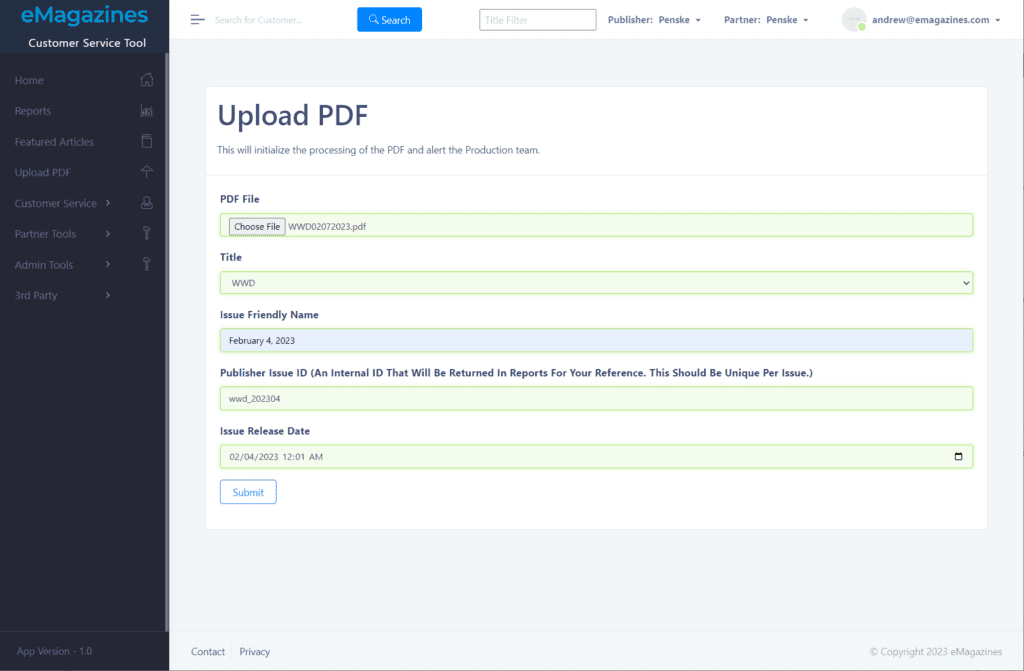
Step 2. Review and adjust the styling
Next, the platform will automatically convert your PDF into single-column content that is legible on any device. Here’s an example of what this looks like in eMagazines:
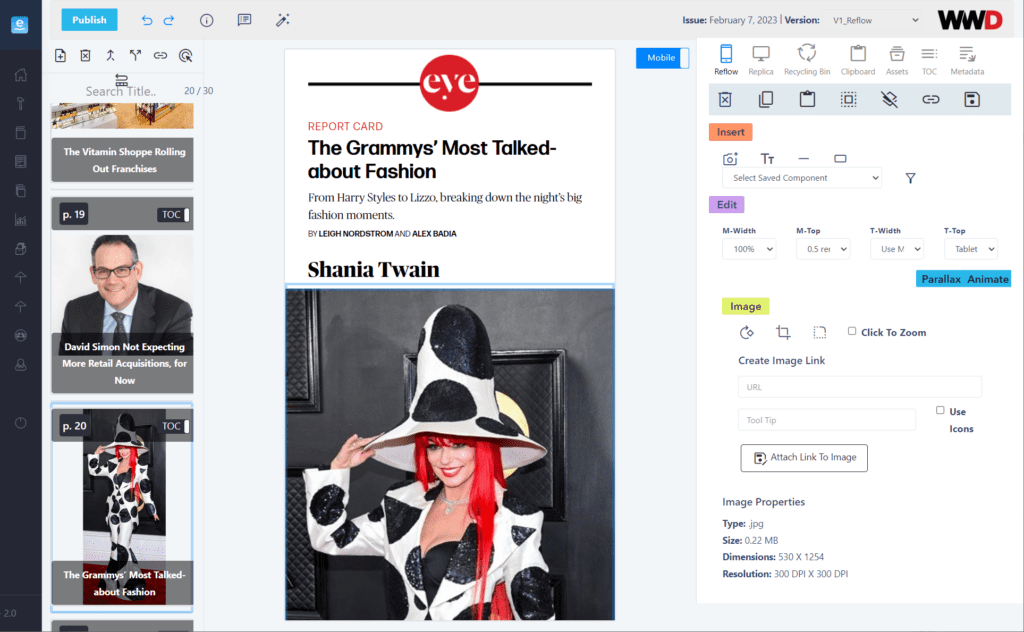
You should review every article to check the styling. eMagazines will automatically use the branding in your pdf, including fonts and colors for headlines, bylines, copy, and more. Your job is to check for brand alignment, and adjust anything at a global scale. You should also review the articles for any errors or quality issues.
Step 3. Test out the table of contents
The table of contents will also be automatically generated. This allows readers to easily hop around your digital edition and select the article they want to read instead of just flipping through.
All you need to do is check the headlines, bylines, and descriptions.
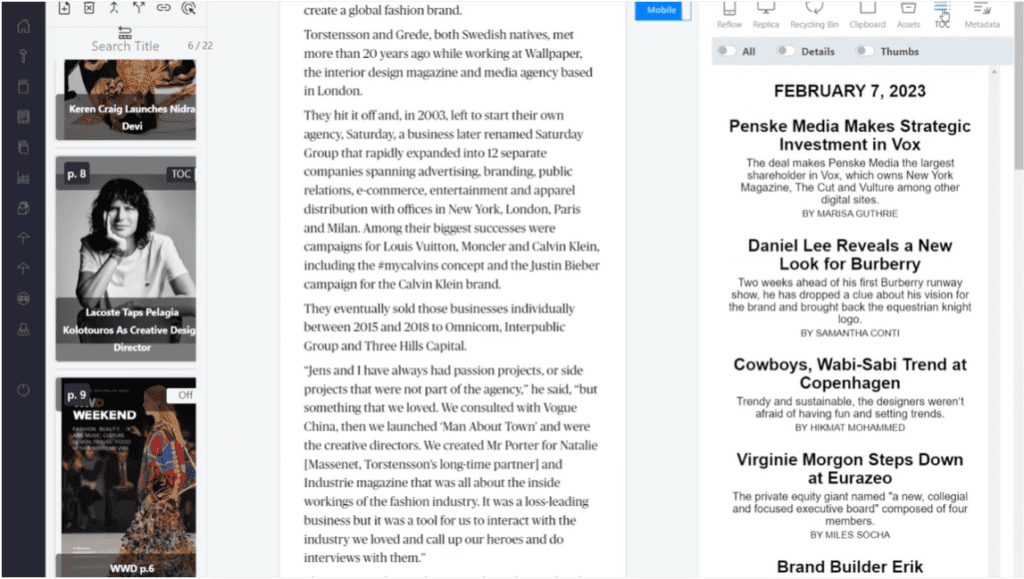
Step 4. Add deep links to your cover page
One of the awesome things about digital magazines is interlinking. Not only can readers click on articles from the table of contents, but they can also click on articles in the cover page.
You can create a link for an article featured in your cover page and then draw a square on the area where you want the link to go. Do this for all of your cover articles.
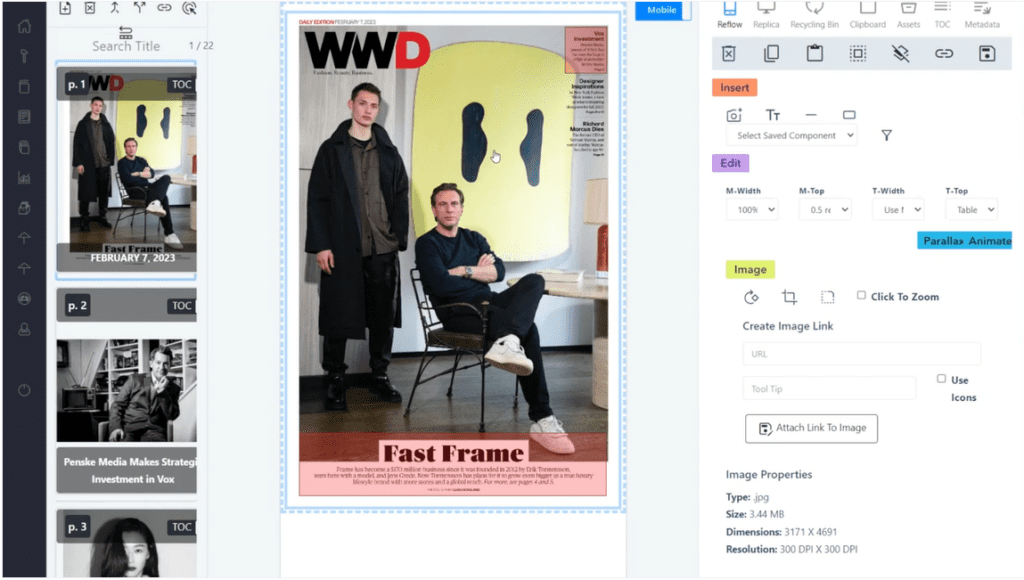
Step 5. Preview the magazine on multiple devices
The final step is to preview your magazine as a reader.
Test it out using a mobile phone, tablet, and computer.

Now your magazine is ready to be distributed. Scroll to the bottom of this article for tips on delivery and distribution.
For more details (including how to automatically add article audio to your digital magazine), check out this tutorial on PDF to digital magazine conversion .
Top 5 digital magazine publishing software
Check out these top tools for publishing digital magazines:
1. eMagazines
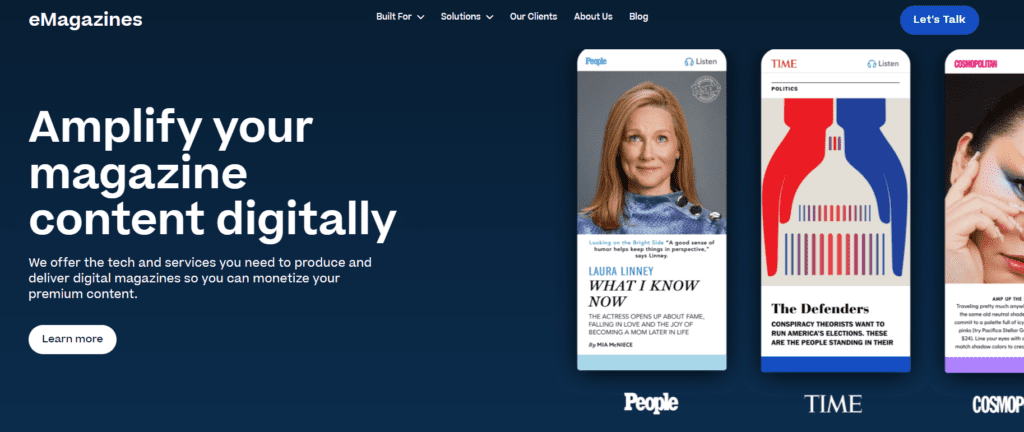
eMagazines is a software and service provider for converting print magazines to digital magazines. Unlike basic PDF magazine conversion tools , which embed your PDF in an online viewer , eMagazines completely reflows your content so that it’s easy to read on any device. Readers never have to pinch and zoom in an unoptimized PDF. Instead, they can scroll and flip through single-column content. In addition to a superior reading experience, eMagazines also offers services to help you sell, deliver, and distribute your digital magazine.
Best for : Magazine publishers (national, regional, and niche)
Top features :
- Mobile-optimized magazine reader
- White labeled experience
- No need for passwords or content downloads
- Custom services for production and delivery
- Automated article audio
- Subscriber back issue access
- Delivery to Apple News+
- Native app building and maintenance
- Customer acquisition partnerships
- Analytics and custom reporting
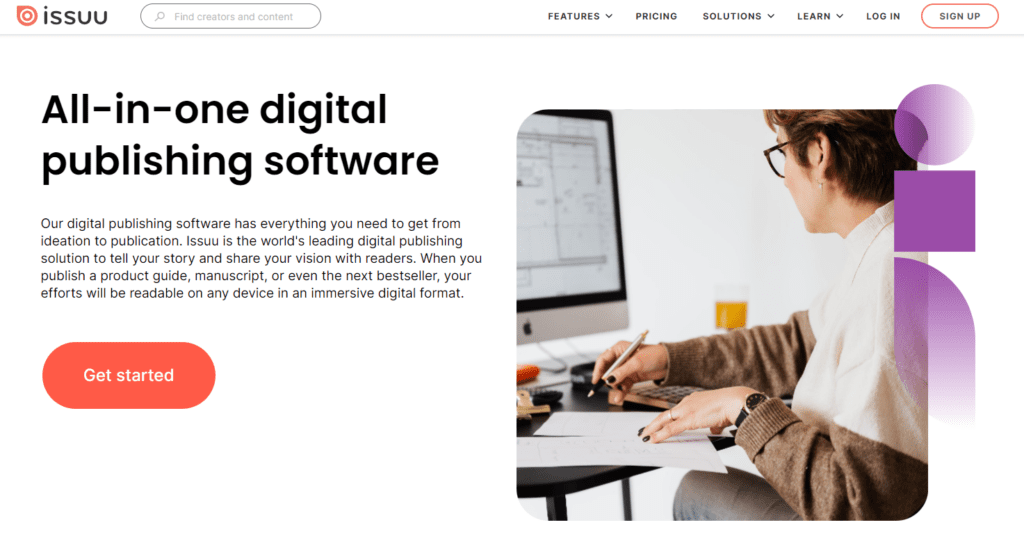
Issuu is a simple tool for publishing digital magazines. In addition to publishing digital flipbooks, you can also use Issuu for SEO blog posts, social media posts, and gifs. Keep in mind that this solution is best for content marketing and small business use cases, but it’s not a fit for distributing quality digital magazines to subscribers because the reading experience is too complex.
Best for : One-off publications
- Works for digital magazines and catalogs
- Project management features
- SEO optimization
- Fullscreen viewing
- Sales and subscriptions management
- Payment processing
3. Flipsnack
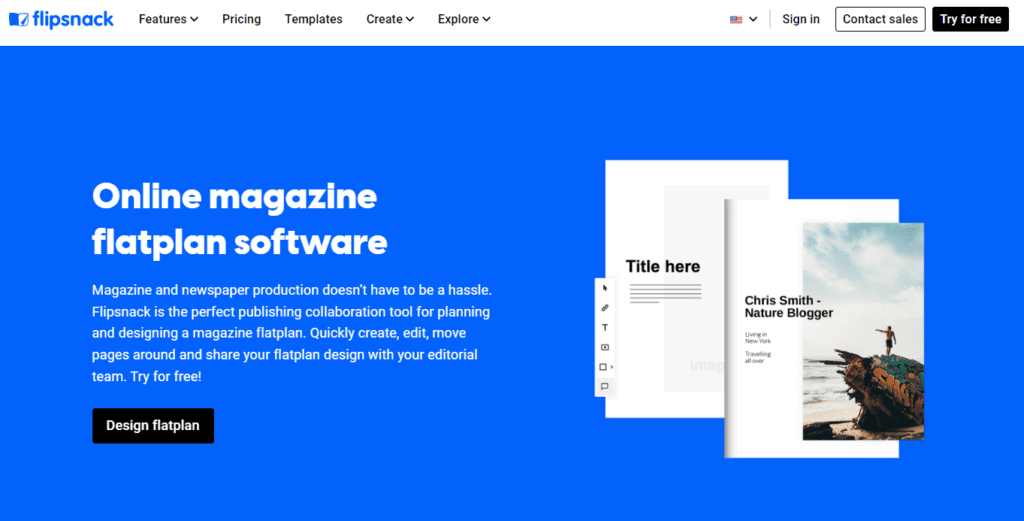
Flipsnack is similar to Issuu in that it’s a simple online software for creating digital flipbooks. If you want to publish a digital magazine, you can either upload a PDF that you designed using adobe or Canva, or you can use Flipsnack’s online design editor to create a digital magazine from scratch.
- Converts PDFs to digital magazines
- Catalog design software
- QR code generator
- Custom subdomains
- Team collaboration and project management
- Content viewing analytics
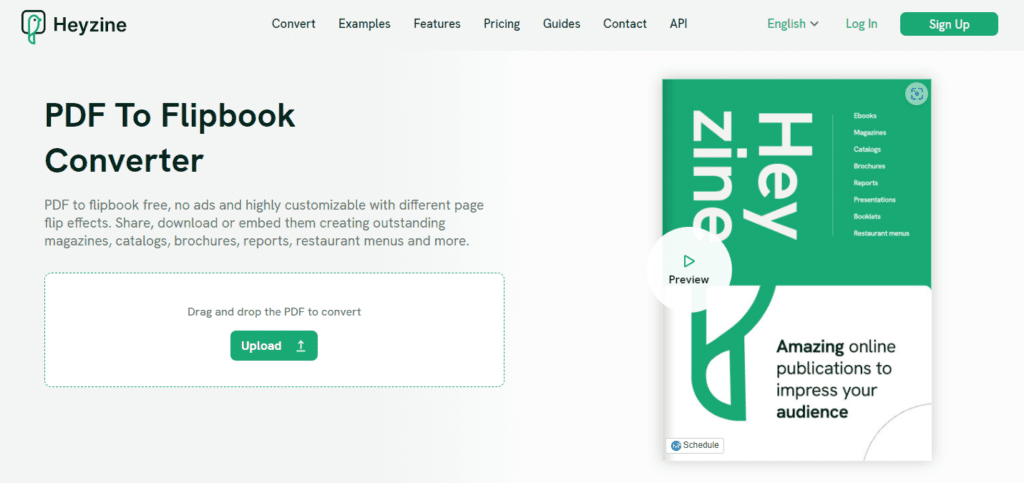
Heyzine offers a free plan that will appeal to small businesses and creators. You can use it for magazines, catalogs, brochures, reports, restaurant menus, and more. Heyzine does not offer a magazine design program, so you must have a PDF to upload. PDF content will then be embedded in a mobile viewer, however, readers will have to pinch and zoom because PDF content usually appears quite small when not in print.
- Mobile responsive
- Interlinking from one flipbook or page to another
- Supports videos, audio, and pictures

Foleon is a different sort of digital magazine software because it’s designed for enterprises rather than media companies. It offers content marketing features and integrations so that you can deliver digital magazine content at scale to both customers and internal contacts. The program can be used for marketing and employee communications campaigns.
Best for : Enterprises and marketing teams
- Content editor
- Drag and drop magazine design
- White labeled branding
- Templates for magazines, ebooks, and catalogs
- Integrations with marketing analytics software
Tips for publishing a digital magazine
Publishers have much to consider when creating a digital version for the first time or revamping their current digital edition process. Follow these tips for reader experience and growth.
1. Make sure the reading experience is mobile optimized (PDFs don’t cut it)
For small creators, PDF conversion tools might do the trick. But readers expect more from media companies.
Here’s an example of a digital magazine made with Heyzine (as you can see the font comes up quite small on a laptop).

And here’s an example of how easy it is to read single-column content created with eMagazines (from People):

As you can see, it’s a lot more legible! This mobile optimized content looks great in tablets, phones, and computers. And you’re still able to retain your branding through fonts and colors.
2. Eliminate the need for passwords
Consumers today have hundreds if not thousands of passwords. If you require a password to read your digital magazine, you’re setting yourself up for a constant stream of customer support requests related to login issues. Fortunately, it’s not necessary to require user passwords to distribute content securely to paying subscribers. Instead, you can deliver digital magazines via email and/or a mobile app.
Learn more about those options here:
- Email magazine delivery
- Mobile magazine app
3. Continuously experiment with new subscription offers
It’s important to A/B test your magazine subscription order pages so you can optimize your messaging and checkout flow. But A/B testing is about more than UX and copy. To really experience an uplift in conversions, you should test the offers.
For example, you might try different prices, subscription lengths, and trial periods. You can also try different content offers that come for free with a subscription. Along with a new subscription, you might offer access to five special issues or your entire back issue archive .
4. Increase retention with a great reader experience and extra benefits
Have you ever heard the phrase “surprise and delight?” It refers to the extra benefits you offer customers that they’re not expecting. You should have a retention strategy in place that will give customers additional reasons to stay subscribed and keep consuming your content. This might include special virtual events, special edition access, community forums, and other premium add-ons that digital magazine subscribers get for free.
Of course, you’ll also want to ensure that the reading and delivery experience is seamless so subscribers can easily and regularly engage with your main content.
5. Use distribution partnerships to increase your reach
You should always be looking for ways to scale your content beyond your own customer base. And the way to do that is through customer acquisition and distribution partnerships . For example, you could partner with Hoopla and Magazine Jukebox to distribute your digital edition in airports, airlines, medical offices, and universities. For some partnerships, you might get paid for the content and for others, you might provide the content for free in the hopes that readers want more and decide to subscribe.
Publishing a digital magazine is all about easy access. So make sure to choose the solution and strategies that will please your readers the most.
Learn more about eMagazines’ software and services.
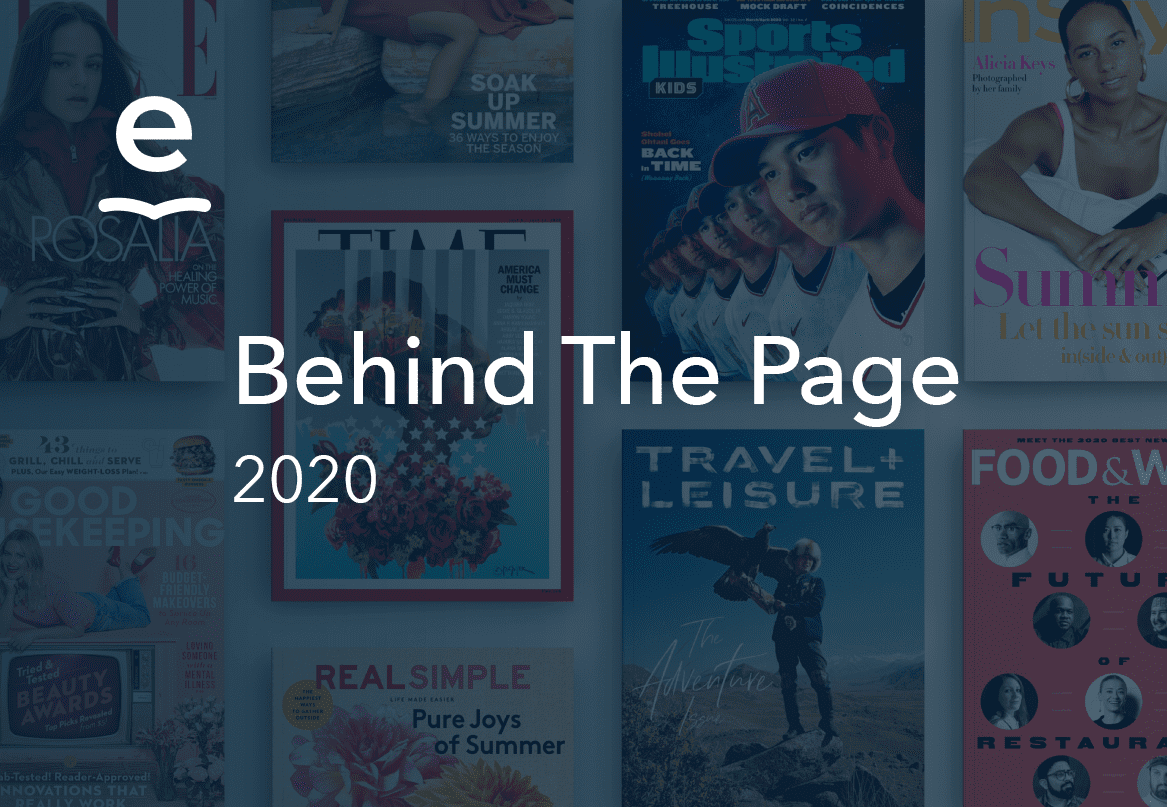
Behind the Page of 2020: Journalism’s Journey in America

Behind the Page: Why The Atlantic’s Yasmeen Serhan is telling the global stories we need now

How to Create a Winning Digital Magazine Marketing Strategy

Home » Self-Publishing » How to publish a magazine

5 steps to create and publish your own magazine
Step 1: do your research.
Before you get started, ask yourself the following questions:
- Who is your competition, and how large is their following?
- How will your magazine be different and stand out?
- Who is your target demographic, and how can you appeal to them? How does your content match what they like? Which brands do they use, and how can any advertising connect with your readers?
- What components of other magazines do you like or dislike?
- What will your design and layout look like? Create mood boards and collect samples you like.
- How will you publish your magazine—traditional printing, self-publishing, or online? How will you get copies to subscribers?
Doing this research up front will help you create a successful self-publishing plan.
Step 2: Create your content
Don’t underestimate how long it takes to create quality content. Some magazines can take as long as six months to put together. It may be helpful to create your first TWO issues, so you can build a window to create the next two while you release the completed set.
When self-publishing a magazine, focus on quality over quantity. Don’t be afraid to start small and slowly grow your page count over time. It is better to have 10 pages of excellent content than 20 pages of ‘OK’ content. Also, more frequent publications will help you build your audience. If shorter publications mean more frequent issues, that use the shorter length to your advantage that way.
As well as creating content yourself, consider asking fellow creatives to submit their ideas. As your audience grows, you could also invite contributions from your readership.
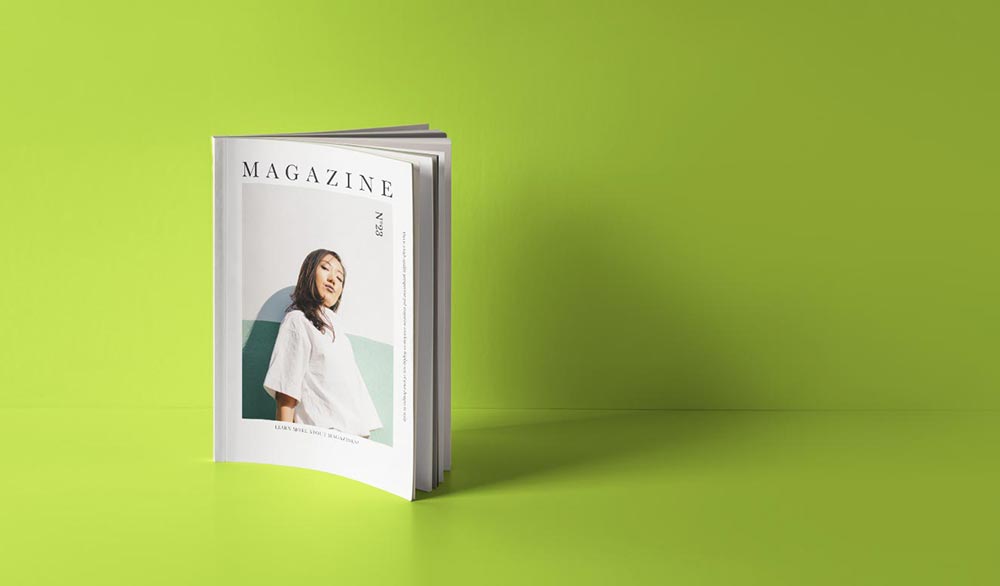
Step 3: Lay out your magazine
Now that you have all of your content, it’s time to decide on the layout, including which piece will earn the honor of being your cover story.
Magazines are known for their varied and dynamic layouts. You want to create layouts that show off the best aspect of each piece of content while also guiding the reader’s eye through the story. Do the images carry the story? Consider layouts with large image space and marginalized text. Is the story carried by text? Look for layouts that have a clear flow from one column and a text box to the other for easier reading, creating close connections with images without letting the images overwhelm them. Your best place to start is by copying page layouts you like from other publications and matching them to your content.
If you’re just getting started, why not use one of our pre-designed professional templates . They include everything you need to create a newsstand-quality magazine, from mastheads to editorial features.
Step 4: Proofread, proofread, proofread
Proofreading is extremely important for any type of self-published magazine, especially so if you are printing it. Unlike a digital version, there is no going back to fix a misspelled word once your magazine has gone to print. In addition to any spelling errors, you will want to check things like text alignment, line breaks, and image placement.
After you have proofed your final product several times, pass your magazine off to someone else to check as well. A fresh pair of eyes will be able to catch small errors that you may have missed.
We recommend printing a single proof copy for this phase of the review. Errors show up in print that are impossible to catch on a screen.
Step 5: It’s time to publish your magazine!
Now that all of the hard work has been done and your magazine is ready for the public eye, it is time to publish. Make sure to promote your magazine using your social media channels and website if you have one.
Pro Tip: Keep an up-to-date database of your magazine subscribers. Grow your digital mailing list. This will come in handy when soliciting articles and allows you to track the growth of your self-published magazine.
Need some guidance? Visit our blog for tips on making a magazine .
Ready to put your ideas in print? Create a newsstand-quality magazine —perfect for serial content or high-volume printing projects. Premium and economy print options are available.
Magazine , Templates
This post doesn't have any comment. Be the first one!
This is a unique website which will require a more modern browser to work! Please upgrade today!
This is a modern website which will require Javascript to work.
Please turn it on!
How to Publish a Magazine: A Step-by-Step Guide to Self-Publishing Magazines
- June 15, 2023
- Post Views: 1,685
Are you interested in how to publish a magazine but don’t know where to start? Self-publishing a magazine can be a rewarding experience, but it can also be overwhelming if you don’t have a plan. In this step-by-step guide, we’ll walk you through the process of publishing a magazine from start to finish. Whether you’re creating a niche publication or a general interest magazine, we’ve got you covered. By the end of this guide, you’ll have a recommended tool you will need to create a magazine that engages your readers and reflects your brand. Let’s get started!
How to Publish a Magazine With 5 Easy Steps
1. planning.
The first step in publishing a magazine is to plan your content carefully. Determine your target audience, choose a niche, and decide on the type of content you want to include. Creating an editorial calendar can help you stay organized and on track. Consider conducting market research to identify gaps in the market and to ensure that your magazine meets the needs of your target audience. You may also want to consider the frequency of your publication and how much content you’ll need to produce for each issue.
Once you have your content planned out, it’s time to design your magazine. Choose a layout that complements your content and reflects your brand. Consider hiring a graphic designer to help you create a professional-looking magazine. Make sure your design is visually appealing and easy to navigate, with clear headings and subheadings that guide your readers through the content. You may also want to consider the use of color, typography, and images to enhance the overall look and feel of your magazine.

3. Content Creation
With your design in place, it’s time to create your content. Write articles, take photos, and create graphics that will engage your readers. Make sure your content is high-quality and relevant to your target audience. Consider using a mix of short-form and long-form content to keep your readers engaged and interested.
4. Editing and Preview
Before you publish your magazine, make sure to edit and preview your content thoroughly. Check for spelling and grammar errors, and make sure your articles flow well and are easy to read. Consider hiring a professional editor to help you polish your content and ensure that it meets the highest standards.
5. Printing and Publishing
Once your magazine is complete, it’s time to print and distribute it. Choose a printing company that specializes in magazine printing, and consider using a publishing service to help you get your magazine into the hands of your target audience. Consider offering both print and digital versions of your magazine to reach a wider audience. You may also want to consider partnering with other businesses or organizations to help promote your magazine and increase its visibility.
Magazine Publishing Software – Flip PDF Plus Pro
Flip PDF Plus Pro is an exceptional software for publishing magazines that enables users to create interactive digital magazines with a lifelike page-flipping effect. It offers a plethora of features that can enrich the reading experience for users, including multimedia elements such as videos, audio, and animations. The software’s key features include:
- Multimedia Support: Flip PDF Plus Pro empowers users to add multimedia elements such as videos, audio, and animations to their flipping magazines. This feature can significantly enhance the reading experience and make the content more captivating.
- Realistic Page-flipping Effect: This digital magazine maker employs a realistic page-flipping effect that emulates the experience of reading a physical magazine. This feature can make the digital magazine feel more immersive and engaging, providing a unique reading experience.
- Mobile-friendly: Digital magazines made with Flip PDF Plus Pro are mobile-friendly and can be viewed on a variety of devices, including smartphones and tablets. This feature ensures that readers can access the magazine content anytime, anywhere, on any device, making it more convenient and accessible.
Publishing a digital magazine can be a challenging experience. With this step-by-step guide, you’ll have the tools you need to self-publish a magazine that stands out from the crowd. Remember to plan your content carefully, design your magazine with your readers in mind, create high-quality content that engages your audience, edit and proofread your work thoroughly, and distribute your magazine to your target audience. By following these steps, you’ll be well on your way to creating a successful magazine that reflects your brand and resonates with your readers. Good luck!
- create digital magazine , how to publish an online magazine , how to publish magazine , how to self publish a magazine , magazine making software , magazine publishing software
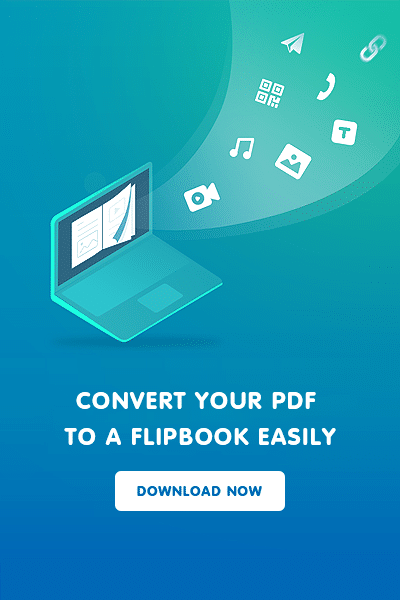
Table of Contents
Latest posts, 7 inspiring training book pdf examples: read before crafting your training manual.
Research indicates that 94% of employees won’t quit if they are offered training and development opportunities. This points out that a company that gives support
7 Interactive Brand Identity PDFs You Should Not Miss
Just as everyone has their own personality and values, so does each brand exhibit its distinctive characteristics that make it different from competitors in the
Style Guide: Brand’s Playbook Explain for Dummy
A playbook is a manual that outlines a football team’s plays and strategies to win a game. When it comes to the branding campaign, a
8 Brand Guideline Template Websites for Design Inspiration
A brand requires a brand guideline to build a strong visual identity. With a well-outlined brand guideline, your workforce is more likely to ensure consistency
Copyright © 2007 – 2024 FlipBuilder. All rights reserved.
- PRO Courses Guides New Tech Help Pro Expert Videos About wikiHow Pro Upgrade Sign In
- EDIT Edit this Article
- EXPLORE Tech Help Pro About Us Random Article Quizzes Request a New Article Community Dashboard This Or That Game Popular Categories Arts and Entertainment Artwork Books Movies Computers and Electronics Computers Phone Skills Technology Hacks Health Men's Health Mental Health Women's Health Relationships Dating Love Relationship Issues Hobbies and Crafts Crafts Drawing Games Education & Communication Communication Skills Personal Development Studying Personal Care and Style Fashion Hair Care Personal Hygiene Youth Personal Care School Stuff Dating All Categories Arts and Entertainment Finance and Business Home and Garden Relationship Quizzes Cars & Other Vehicles Food and Entertaining Personal Care and Style Sports and Fitness Computers and Electronics Health Pets and Animals Travel Education & Communication Hobbies and Crafts Philosophy and Religion Work World Family Life Holidays and Traditions Relationships Youth
- Browse Articles
- Learn Something New
- Quizzes Hot
- This Or That Game New
- Train Your Brain
- Explore More
- Support wikiHow
- About wikiHow
- Log in / Sign up
- Education and Communications
How to Self Publish a Magazine
Last Updated: November 20, 2023 Approved
wikiHow is a “wiki,” similar to Wikipedia, which means that many of our articles are co-written by multiple authors. To create this article, 57 people, some anonymous, worked to edit and improve it over time. wikiHow marks an article as reader-approved once it receives enough positive feedback. This article received 21 testimonials and 93% of readers who voted found it helpful, earning it our reader-approved status. This article has been viewed 471,381 times. Learn more...
If there's something you're really passionate about, self-publishing your own magazine can be a fun way to share it with an audience! We'll help you get your magazine up and running, from researching your competition to finalizing your layout and sending out copies.

- Is there a magazine currently in circulation that is already providing similar content?
- What makes it a winner?
- What makes it a loser?
- How will your magazine be better?
- Or, will your magazine be absolutely the only one of its kind reaching your target demographic?
- What is your target demographic looking for in a magazine?
- What other magazines are targeting the same demographic?
- From which can you learn the successes?
- From which can you learn the failures?

- What are your printing options versus your budget?
- How many pages need to be color, and how many can be black and white?
- What is your circulation target?
- What are your circulation and distribution options?
- Is sponsorship an option?
- Is it possible to secure advertisers for your first run before going to press?

- On your site, you should have a page for contributors. This allows you to mark deadlines, point out what sorts of articles you'd like to receive, and let writers know how you'll be using their work. List your pay rates and what rights you intend to purchase.
- You should also have a way for people to subscribe online, if at all possible. Paypal is a good way to do this, at least when you're just starting out. If you don't want to take subscription orders online, make sure your address is easy to find and note what forms of payment you DO take. If you accept checks or money orders, you'll need to get a DBA (doing business as) so that your bank will accept checks made out to your magazine name.

Community Q&A
- Consider hiring a video designer and then make a YouTube channel for the magazine. Just make sure it is relatively well-known first. In addition, YouTube channels can significantly increase your audience. Thanks Helpful 0 Not Helpful 0
- Don't be afraid to contact experts in your magazine's field and ask them to contribute. Thanks Helpful 0 Not Helpful 0
- Try to set up your website as a resource, rather than just a subscription porthole. If you can build your site up enough with sought-after material, you'll have a much easier time finding subscribers. Thanks Helpful 0 Not Helpful 0

- Don't be afraid to ask for help when you need it. Thanks Helpful 11 Not Helpful 0
- You May need to hire a few of your friends to help you do it just give them some of the profit! Thanks Helpful 7 Not Helpful 1
- Be prepared to grow. The more subscribers you have, the more time you'll have to spend dealing with them. Thanks Helpful 1 Not Helpful 0
- Keep on schedule. It's so easy to slip behind, and your subscribers won't be pleased. Thanks Helpful 1 Not Helpful 0
Things You'll Need
- A good black and white laser printer with duplexing capabilities.
- A reliable printing service for your covers.
- A saddle stapler.
- Word, as well as software programs, for layout, photo editing, and spreadsheets.
- It helps if you have Photoshop
You Might Also Like

- ↑ https://medium.com/marketing-102/how-to-self-publish-your-magazine-and-increase-your-business-reach-3e7d13424ad0
- ↑ https://medium.com/the-mission/how-to-self-publish-a-magazine-in-30-days-12038a8b3bb8
- ↑ https://www.entrepreneur.com/article/160238
About This Article
- Send fan mail to authors
Reader Success Stories
Sandra Greene
Apr 13, 2016
Did this article help you?

Aug 20, 2017
Teresa Santamaria
Feb 15, 2017
Elnar Nalangan
Aug 29, 2018
Somashekar Chandran
Apr 18, 2016

Featured Articles

Trending Articles

Watch Articles

- Terms of Use
- Privacy Policy
- Do Not Sell or Share My Info
- Not Selling Info
Get all the best how-tos!
Sign up for wikiHow's weekly email newsletter
Get smartphone savvy the easy way: Join our 7-day email challenge to receive helpful tips each day.
Popular Searches
AARP daily Crossword Puzzle
Hotels with AARP discounts
Life Insurance
AARP Dental Insurance Plans
Suggested Links
AARP MEMBERSHIP — $12 FOR YOUR FIRST YEAR WHEN YOU SIGN UP FOR AUTOMATIC RENEWAL
Get instant access to members-only products and hundreds of discounts, a free second membership, and a subscription to AARP the Magazine.
- right_container
Work & Jobs
Social Security
AARP en Español
- Membership & Benefits
- AARP Rewards
- AARP Rewards %{points}%
Conditions & Treatments
Drugs & Supplements
Health Care & Coverage
Health Benefits

Staying Fit
Your Personalized Guide to Fitness

AARP Hearing Center
Ways To Improve Your Hearing

Brain Health Resources
Tools and Explainers on Brain Health

How to Save Your Own Life
Scams & Fraud
Personal Finance
Money Benefits

View and Report Scams in Your Area

AARP Foundation Tax-Aide
Free Tax Preparation Assistance

AARP Money Map
Get Your Finances Back on Track

Budget & Savings
Make Your Appliances Last Longer
Small Business
Age Discrimination

Flexible Work
Freelance Jobs You Can Do From Home

AARP Skills Builder
Online Courses to Boost Your Career

31 Great Ways to Boost Your Career

ON-DEMAND WEBINARS
Tips to Enhance Your Job Search

Get More out of Your Benefits

When to Start Taking Social Security

10 Top Social Security FAQs

Social Security Benefits Calculator

Medicare Made Easy
Original vs. Medicare Advantage

Enrollment Guide
Step-by-Step Tool for First-Timers

Prescription Drugs
9 Biggest Changes Under New Rx Law

Medicare FAQs
Quick Answers to Your Top Questions
Care at Home
Financial & Legal
Life Balance

LONG-TERM CARE
Understanding Basics of LTC Insurance

State Guides
Assistance and Services in Your Area

Prepare to Care Guides
How to Develop a Caregiving Plan

End of Life
How to Cope With Grief, Loss
Recently Played
Word & Trivia
Atari® & Retro
Members Only
Staying Sharp
Mobile Apps
More About Games

Right Again! Trivia

Right Again! Trivia – Sports

Atari® Video Games

Throwback Thursday Crossword
Travel Tips
Vacation Ideas
Destinations
Travel Benefits

Beach vacation ideas
Vacations for Sun and Fun

Plan Ahead for Tourist Taxes

AARP City Guide
Discover Seattle

How to Pick the Right Cruise for You
Entertainment & Style
Family & Relationships
Personal Tech
Home & Living
Celebrities
Beauty & Style

TV for Grownups
Best Reality TV Shows for Grownups

Robert De Niro Reflects on His Life

Free Online Novel
Read 'Chase'

Sex & Dating
Spice Up Your Love Life

Navigate All Kinds of Connections

How to Create a Home Gym

Store Medical Records on Your Phone?

Maximize the Life of Your Phone Battery

Virtual Community Center
Join Free Tech Help Events

Create a Hygge Haven

Soups to Comfort Your Soul

AARP Smart Guide
Spring Clean All of Your Spaces
Driver Safety
Maintenance & Safety
Trends & Technology

How to Keep Your Car Running

We Need To Talk
Assess Your Loved One's Driving Skills

AARP Smart Driver Course

Building Resilience in Difficult Times

Tips for Finding Your Calm

Weight Loss After 50 Challenge

Cautionary Tales of Today's Biggest Scams

7 Top Podcasts for Armchair Travelers

Jean Chatzky: ‘Closing the Savings Gap’

Quick Digest of Today's Top News

AARP Top Tips for Navigating Life

Get Moving With Our Workout Series
You are now leaving AARP.org and going to a website that is not operated by AARP. A different privacy policy and terms of service will apply.
Go to Series Main Page
Writer's Guidelines
Thank you for your interest in submitting a story idea to AARP The Magazine for review. The magazine rarely uses unsolicited ideas. Any material you submit will not be returned. That said, writers may submit pitches based on the following guidelines:
Story idea letters should be no more than one page long and should provide links to recent writing samples. Your letter should present your idea, give details on how you would approach it, provide some sense of your writing style, and name the section of the magazine for which the piece is intended.
Do not submit the full text of the story you are proposing unless it’s a personal essay. Do not send us email attachments.
We cover stories of interest to people over 50 in these categories:
- Work and Money: investments, savings, retirement, and job issues
- Health and Fitness: tips, trends, studies
- Food and Nutrition: recipes, emphasis on healthy eating
- Travel: tips and trends on how and where to travel
- Consumerism : practical information and advice
- Relationships: family matters, caregiving, living arrangements, grandparenting
- Human Interest: dramatic, recent, inspiring narratives about people over 50
- Personal Essay: thoughtful, timely, new takes on matters of importance to our readers
Due to a deluge of plagiarized and A.I.-generated submissions from overseas, we must unfortunately note the following:
- If you submit a plagiarized pitch, we will blacklist and block you.
- If you submit a pitch written by A.I., we will blacklist and block you.
- If your pitch makes it clear that you don’t speak English very well, we will blacklist and block you.
- If you submit a pitch and you are not based in North America, we will blacklist and block you.
- If a website told you we pay easy money for writing, we’re sorry but the website lied to you.
To submit your pitch, either e-mail it to [email protected] as plain text within the body of your message or mail it to the following address:
AARP The Magazine c/o Editorial Submissions 601 E St. NW Washington, DC 20049
Discover AARP Members Only Access
Already a Member? Login

AARP NEWSLETTERS

%{ newsLetterPromoText }%
%{ description }%
Privacy Policy
ARTICLE CONTINUES AFTER ADVERTISEMENT
AARP VALUE &
MEMBER BENEFITS

Denny's
15% off dine-in and pickup orders

AARP Travel Center Powered by Expedia: Vacation Packages
$50 gift card of your choice when booking any flight package

$20 off a Walmart+ annual membership

AARP® Staying Sharp®
Activities, recipes, challenges and more with full access to AARP Staying Sharp®
SAVE MONEY WITH THESE LIMITED-TIME OFFERS
- Share full article
Advertisement
Supported by
A New Chapter for Sports Illustrated, With Plans to Keep Print
Minute Media, owner of The Players’ Tribune, has struck a deal to operate Sports Illustrated for at least 10 years.

By Benjamin Mullin
The owner of Sports Illustrated said it had chosen a new company to publish the magazine, a deal that could settle some of the recent friction at the storied publication and continue the print edition.
Authentic Brands Group, which owns the intellectual property rights to Sports Illustrated as well as to celebrities like Marilyn Monroe and Muhammad Ali, said it had struck a long-term deal to license Sports Illustrated’s publishing rights to Minute Media, a digital-media company focused on sports.
Minute Media’s license with Sports Illustrated will stretch for 10 years with an option to extend for up to 30 years total, into the magazine’s centenary. Both companies expect the deal, which also includes Sports Illustrated’s Swim brand, to last for the full 30-year term. The companies declined to disclose financial terms but said that Authentic Brands Group was taking a stake in Minute Media as part of the deal.
The deal is a significant expansion for Minute Media, a New York-based company founded in 2011 whose holdings — which include the sports websites The Players’ Tribune and Fansided — generate more than $400 million in revenue annually.
Sports Illustrated has been engulfed in turmoil for months, the result of a corporate tug of war between the company that owns the iconic magazine and the energy drink mogul whose executives have been running it. The agreement begins immediately and effectively wrests Sports Illustrated’s operations away from Arena Group, the digital-media company that has run the magazine since 2019 and threatened to end its print edition .
A spokesman for Arena Group said the company had been informed of the deal with the new licensee and had no other details.
It is a new chapter for Sports Illustrated, which published its first issue in 1954. Asaf Peled, the chief executive of Minute Media, said in an interview that he planned to continue Sports Illustrated’s print edition.
“In the current era of digital, it’s still not trivial and quite difficult to build your own brand and get people to know and admire it,” Mr. Peled said. “So once you get the opportunity to work with and grow an iconic brand like Sports Illustrated, you take it.”
Sports Illustrated has been in a state of limbo for months. In January, Authentic Brands Group terminated Arena Group’s license to operate the magazine after the company missed a $3.75 million licensing payment. That month, Arena Group — which continued to run Sports Illustrated while it was in breach of its licensing agreement — told Sports Illustrated employees that many would be laid off and notified others that they would remain on staff for 90 days. Last week, Arena Group executives told employees they would stop printing the magazine after its May issue.
Minute Media plans to expand the magazine’s publishing operations globally, Mr. Peled said, and to hire back some of the employees whom Arena Group had laid off. He added that he would not know how many employees would return until Minute Media started operating the business this week.
Mr. Peled said Minute Media was focused on “short-form sports content creation,” making video, audio and text for consumption on mobile devices. It owns Fansided, which features articles and podcasts for sports fans and for several years was owned by Sports Illustrated’s former publisher, Time Inc.; and The Players’ Tribune, which publishes videos and essays by athletes and was founded by Derek Jeter, the Yankees Hall of Fame shortstop. Mr. Peled said he also wanted to continue Sports Illustrated’s tradition of in-depth journalism.
“It’s an exception to our core strategy, but it’s not the first time we’ve done that,” Mr. Peled said.
An alert published with this article referred incompletely to a deal to operate Sports Illustrated. Minute Media agreed to run the publication for at least 10 years, with an option to extend for up to 30 years total; it did not commit to 30 years.
How we handle corrections
Benjamin Mullin reports on the major companies behind news and entertainment. Contact Ben securely on Signal at +1 530-961-3223 or email at [email protected]. More about Benjamin Mullin
Explore Our Business Coverage
Dive deeper into the people, issues and trends shaping the world of business..
Phoenix Housing Crunch: A swelling population coupled with development restrictions have contributed to a dire shortage of affordable housing in the biggest city in Arizona , one of the six states likely to determine the U.S. presidential election.
A Billionaire Online Warrior: Bill Ackman, an obstinate hedge-funder who loves a public crusade, has used X to push himself into a new realm of celebrity .
Cancel Smartphones: The N.Y.U. professor Jonathan Haidt became a favorite in Silicon Valley for his work on what he called the “coddling” of young people. Now, he has an idea for fixing Gen Z .
Landline Pride: Traditional phones may seem like relics in the iPhone era, but a recent AT&T cellular service outage had some landline lovers extolling their virtues.
C.E.O. Dreams: Fresh business school graduates are raising “search funds” from willing investors to buy companies they can lead.
Nelson Peltz Wants Respect: The longtime corporate agitator feels misunderstood . Maybe his fight with Disney could change that.
What to Know About Donald Trump’s New $60 Bible
“all americans need a bible in their home, and i have many. it’s my favorite book.”.

- Share on Facebook
- Share on Twitter

Mother Jones illustration; Shealah Craighead/White House/ZUMA
One month after releasing a line of gilded high-tops for $399, Donald Trump revealed on Tuesday a new item: the Bible. “All Americans need a Bible in their home, and I have many,” the former president explained in a video promoting the country singer Lee Greenwood’s version of a King James translation, the “God Bless the USA Bible.”
“It’s my favorite book,” Trump added.
Throughout the rest of the clip, as if daring us into a collective disgust, Trump swerved through random opportunities to rail against bureaucrats and a country under threat—all while hawking a holy text.
But his latest sales pitch also prompted some legitimate questions. Such as: What the hell is going on? And: Excuse me? Here, we try to answer some of the queries.
So, that first question—what the hell—but more formally: What exactly is Trump promoting and how much will it cost me to shell out for this?
Trump is encouraging his supporters to buy a Bible endorsed by himself and Lee Greenwood. It costs $59.99, without taxes or shipping included. That seems to sit on the more expensive end of Bibles on sale at Barnes & Noble . But those books presumably don’t include copies of the Constitution, the Bill of Rights, and the handwritten lyrics to the chorus of Greenwood’s “God Bless the USA.”
The “God Bless the USA Bible” does include these items .
Trump is in a serious cash crunch . So is he going to make money with this Bible?
According to the book’s official site , the God Bless the USA Bible has nothing to do with Trump’s campaign. It is “not owned, managed, or controlled by Donald J. Trump, The Trump Organization, CIC Ventures LLC, or any of their respective principals or affiliates.” Instead, Trump’s “name, likeness, and image” are being used “under paid license from CIC Ventures LLC.”
Wait, what is CIC Ventures LLC, though?
Okay, so CIC Ventures LLC is, according to the Washington Post , basically a pipeline to Trump:
In [Trump’s] financial disclosure released last year, he’s identified as the [CIC Ventures LLC’s] “manager, president, secretary and treasurer” and the Donald J. Trump Revocable Trust is identified as a 100 percent owner of the business. The same entity also receives royalties from his book “A MAGA Journey” and speaking engagements.
In case it’s not already obvious: if you look at the company’s documents, you’ll find the principal address for CIC Ventures LLC is 3505 Summit Boulevard, West Palm Beach, Florida. That is a Trump golf course . Moreover, in a 2022 disclosure, Nick Luna is listed as a manager. Luna was Trump’s personal assistant and body man.
So, I’m sorry, but let me ask again: Is Trump making money off this?
The New York Times reports that “according to a person familiar” (classic) Trump will receive royalties from sales.
You could have just said that.
I wanted to tell you about the other stuff I found. Any other questions?
Yes. Who is Lee Greenwood?
The country singer who wrote “God Bless the USA.” Greenwood is a fierce MAGA guy who otherwise made news after pulling out of an NRA concert in response to the Uvalde, Texas, mass shooting.
Does Greenwood have a Christmas album with an oddly sexual cover?
Yes. Look at this .
Perfect sweater. Anyway, I feel like I’m experiencing deja vu. Hasn’t Trump made headlines before with a Bible?
You’re probably recalling that despicable photo-op when Trump held up a Bible in front of St. John’s Church, which had been a location of racial justice protests in the days prior. There was a complicated saga, afterward, about whether or not Trump deployed the police to clear protesters to get to the church. An Inspector General’s report ultimately concluded that he did not.
Man, it’s pretty rough remembering all the awful shit we went through with him as president.
Yep. If you ever want to wallow in political depression, check out this quick compilation .
But wait. Wasn’t there another time Trump and the Bible made waves for something far more stupid?
Christian nationalists adore Trump, so there have probably been many times that Trump has referenced the Bible. But you might also be thinking of this incredible clip of Trump attempting to name his favorite verse .
Has a presidential candidate ever partnered on a holy text sale with a country musician?
Not to my knowledge. But this is from a dude who just last week seemed to compare his current legal jeopardy with the persecution of Jesus Christ. Happy Easter!
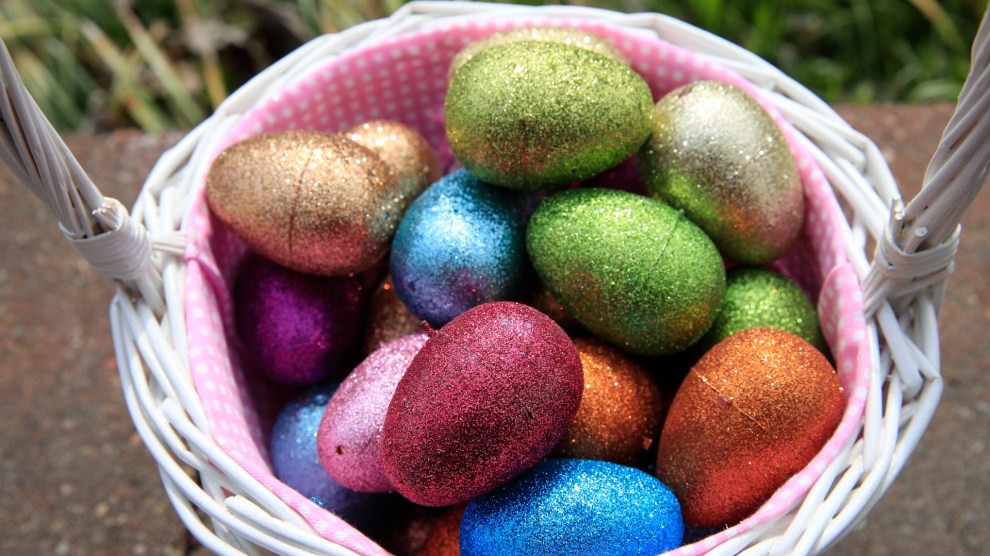
This Easter, “Egg Math” Is the Only Form of TikTok Math I’ll Endorse
Jackie Flynn Mogensen

Republicans Are Suing to Block Another Biden Plan to Provide Student Debt Relief
Hannah Levintova

No One Can Parody Donald Trump Better Than Himself

Traffic Blockade Protests Were a Nuisance. Lawmakers Want to Make Them a Felony.
Nia t. evans
We Recommend

Amid “Rewilding” Trend, a 2,800-Acre English Farm Will Turn to Grassland
Patrick Barkham

Easter Falls on Trans Day of Visibility This Year. The Right Blames Biden.

Donald Trump Stoops to Lowest Low Yet With Violent Post of Biden

The Disturbing Link Between Foster Care and For-Profit Psychiatric Hospitals
Mother Jones
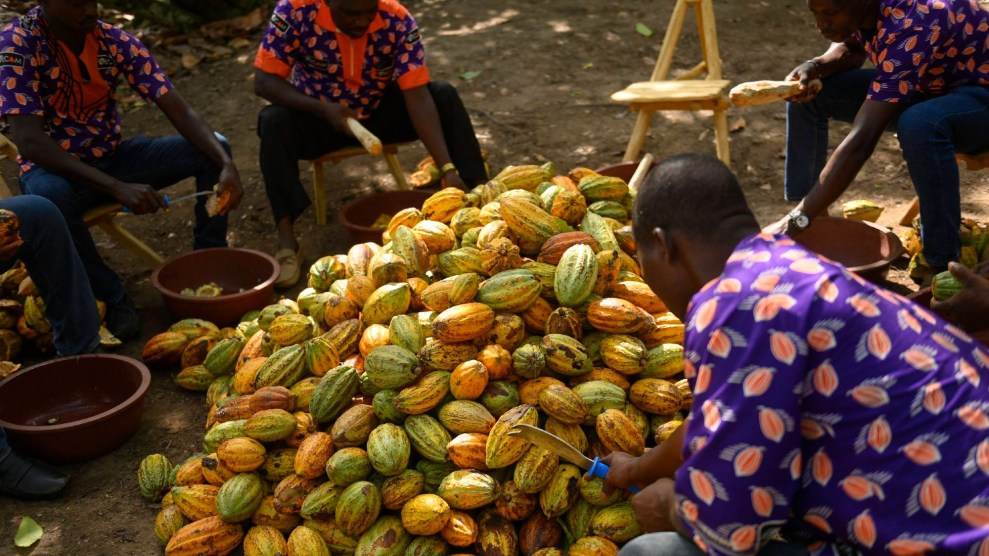
The Easter Bunny Can’t Be Happy About the Global “Chocolate Meltdown”
Patrick Greenfield

In “Quiet on Set,” Justice Isn’t So Simple
Sophie Hayssen

Beyoncé Just Covered the Beatles In the Most Authentic Way: By Honoring Black History
Garrison Hayes

Texas Drops Plans to Execute Man With Intellectual Disability
Julia Métraux
Sign up for our free newsletter
Subscribe to the Mother Jones Daily to have our top stories delivered directly to your inbox.
By signing up, you agree to our privacy policy and terms of use , and to receive messages from Mother Jones and our partners.
Get our award-winning magazine
Save big on a full year of investigations, ideas, and insights.
Support our journalism
Help Mother Jones ' reporters dig deep with a tax-deductible donation.
Independent. In print. In your mailbox.
Inexpensive, too! Subscribe today and get a full year of Mother Jones for just $14.95.

Bold. Brave. Beautiful.
Award-winning photojournalism. Stunning video. Fearless conversations.
Looking for news you can trust?
We noticed you have an ad blocker on..
Can you pitch in a few bucks to help fund Mother Jones' investigative journalism? We're a nonprofit (so it's tax-deductible), and reader support makes up about two-thirds of our budget.
We noticed you have an ad blocker on. Can you pitch in a few bucks to help fund Mother Jones' investigative journalism?
Don't let an algorithm decide what news you see.
Sign up for the free Mother Jones Daily newsletter and follow the news that matters.
- facebook-rs
Biden Is Building a ‘Superstructure’ to Stop Trump From Stealing the Election
For years, Donald Trump has made it abundantly clear that if he doesn’t win the 2024 presidential election , he is willing to cheat and steal it. Since President Joe Biden ’s inaugural address, according to sources with intimate knowledge of the situation, Biden and his inner circle have been drawing up meticulous plans and creating a large legal network focused on wargaming a close election finish, in which the former president and Republican Party launch a scorched-earth, Big Lie – fueled crusade.
Over the past year, Team Biden has been conducting war games, crafting complex legal strategies, and devoting extensive resources to prepare for, as one former senior Biden administration official puts it, “all-hell-breaks-loose” scenarios. The preparations include planning for a contingency in which Biden’s margin of victory is so razor-thin that Trump and the GOP launch a tidal wave of legal challenges and political maneuvers to rerun his 2020 election strategy: declare victory anyways, and try to will it into existence.
Editor’s picks
The 250 greatest guitarists of all time, the 500 greatest albums of all time, the 50 worst decisions in movie history, every awful thing trump has promised to do in a second term.
After the 2020 race was called for Biden, Trump and much of the GOP embarked on a sprawling campaign — a blitz of lawsuits, rabid conspiracy theories, attempts to block certification, and slates of fake electors — to nullify Biden’s clear win. This culminated in the deadly Jan. 6 attack on the U.S. Capitol, which Trump instigated, and led to years of criminal investigations and various indictments, as well as the mainstreaming of the MAGA election-denial movement. The efforts to overturn the election were unsuccessful, largely because Biden had won too many battleground states — unlike when the 2000 presidential race came down to the single state of Florida, and the Republican Party was able to successfully halt the recount of an extremely close vote.
'SNL' Cold Open: Indicted Trump Hawks Bible Complete With Miranda Rights
Trump criticized after posting video depicting biden hog-tied, obama to protester interrupting: 'can’t just talk and not listen'.
Team Biden’s in-house counsels and network of outside lawyers are currently preparing legal strategies for scenarios involving recounts that would make, in the words of one Biden official, “make Florida in 2000 look like child’s play.”
Sources in and around the president’s legal and political operations say the Biden campaign’s current wargaming is informed by questions aides asked themselves in the wake of the 2020 election: What if there’s a rematch in four years with Donald Trump? What do we do if Joe Biden wins and Trump tries to steal the election again?
Bidenworld spent a lot of time pondering such a scenario even before the 2020 election.
In the months leading up to November 2020, Trump offered repeated, public signals that he would try to delegitimize any outcome in which he lost the election. As the threats mounted, Biden’s campaign brass began preemptively working through different nightmare scenarios.
That prep work accelerated in the final weeks of the campaign as an armada of lawyers, numbering in the hundreds, sketched out various unconventional scenarios in which the then-president tried to cling to power in the face of defeat, according to current and former senior Biden campaign officials.
“Biden HQ and the lawyers were essentially preparing for every insane scenario that anyone could think of, so that the campaign wouldn’t be stuck in neutral if the worst actually transpired,” says one attorney familiar with the extensive 2020 wargaming. “Even then, I’m not sure everybody was predicting just how crazy it would become and what Trump would actually do.”
Any attempt by Trump to try and undermine the 2024 election would likely look different than 2020, if only because he lacks the legal authority and access to federal resources he enjoyed as president.
Still, Team Biden has been planning for years sketching out what Trump could do as the leader of the GOP, and has partnered with the Democratic National Committee and a vast network of liberal attorneys and legal groups to conduct similar doomsday-style wargaming.
One swing-state Democratic election official involved with these efforts refers to it as a “superstructure” of various legal teams and liberal operatives who “are going to fight [Team Trump and election deniers] on all fronts and let them have it from all sides, if MAGA wants to tear down our democracy.”
According to two Biden campaign officials and two other sources with knowledge of the operation, draft pleadings and legal motions, for all kinds of possible Trump-related emergencies, are already written and at the ready. In critical swing states such as Georgia, Arizona, and Pennsylvania, Team Biden is regularly in contact with an array of outside counsels and local law firms that have been retained to actively monitor what is happening on the ground, including with regards to the activism of election-denying Trump allies.
In these internal wargames among Bidenworld and Democratic attorneys in key states, this kind of Jan. 6 sequel has included scripts in which House Republicans or state officials refuse to certify a Biden victory — an act that prominent GOP politicians, including on Capitol Hill, have publicly dangled as an option.
A spokesperson for the Democratic National Committee tells Rolling Stone that the national party is also setting aside “tens of millions of dollars in a robust voter protection program to safeguard the rights of voters to make their voices heard against relentless attacks from Donald Trump and the GOP.”
Trump Launches Another Attack on Judge's Daughter, This Time with Photos
Beyonce finds a new freedom and redefines country music on 'cowboy carter' , michigan gop congressman suggests using nuclear strikes like ‘hiroshima’ in gaza.
Of course, if much of the current national and swing-state polling holds, Trump could defeat his successor outright in a 2024 rematch. However, that is almost irrelevant to Trump and his MAGA brain trust’s goals of cementing their “heads I win, tails you lose” philosophy of election administration .
Trump, after all, has continued to falsely claim that the 2016 presidential race was somehow “ rigged ” in Democratic nominee Hillary Clinton’s favor. And that was the election he won.
Sen. Van Hollen Implores Biden: No More Bombs to Israel While Gazans Are 'Starving to Death'
- By Peter Wade
GOP Rep. Bacon Admits 'No Evidence' of Crimes Found in Biden Impeachment Probe
Nancy mace says crime has ‘skyrocketed’ under biden. it hasn’t., trump launches another attack on judge's daughter, this time with photos, house republicans use a big lie to stand up for big pharma.
- By Andrew Perez
Most Popular
Anne hathaway lost roles after oscar win because of 'how toxic my identity had become online,' says christopher nolan backed her: 'i had an angel' in him, where to stream 'quiet on set: breaking the silence' episode 5 online, buckingham palace rushes to clarify queen camilla’s statement that a certain grandson is ‘a handful', touré says diddy terminated his cousin's internship after refusing to sleep with him, you might also like, ‘the way home’ creators break down that mind-bending season 2 finale twist, bitmoji is coming for your pets, the best exercise mats for working out, according to fitness experts, storm reid on ‘euphoria’ season 3 delay: ‘i’m disappointed, but not surprised’, unequal 3-point lines mar women’s elite eight results.
Rolling Stone is a part of Penske Media Corporation. © 2024 Rolling Stone, LLC. All rights reserved.
Verify it's you
Please log in.
Things you buy through our links may earn Vox Media a commission
- The Case for Marrying an Older Man
A woman’s life is all work and little rest. An age gap relationship can help.

In the summer, in the south of France, my husband and I like to play, rather badly, the lottery. We take long, scorching walks to the village — gratuitous beauty, gratuitous heat — kicking up dust and languid debates over how we’d spend such an influx. I purchase scratch-offs, jackpot tickets, scraping the former with euro coins in restaurants too fine for that. I never cash them in, nor do I check the winning numbers. For I already won something like the lotto, with its gifts and its curses, when he married me.
He is ten years older than I am. I chose him on purpose, not by chance. As far as life decisions go, on balance, I recommend it.
When I was 20 and a junior at Harvard College, a series of great ironies began to mock me. I could study all I wanted, prove myself as exceptional as I liked, and still my fiercest advantage remained so universal it deflated my other plans. My youth. The newness of my face and body. Compellingly effortless; cruelly fleeting. I shared it with the average, idle young woman shrugging down the street. The thought, when it descended on me, jolted my perspective, the way a falling leaf can make you look up: I could diligently craft an ideal existence, over years and years of sleepless nights and industry. Or I could just marry it early.
So naturally I began to lug a heavy suitcase of books each Saturday to the Harvard Business School to work on my Nabokov paper. In one cavernous, well-appointed room sat approximately 50 of the planet’s most suitable bachelors. I had high breasts, most of my eggs, plausible deniability when it came to purity, a flush ponytail, a pep in my step that had yet to run out. Apologies to Progress, but older men still desired those things.
I could not understand why my female classmates did not join me, given their intelligence. Each time I reconsidered the project, it struck me as more reasonable. Why ignore our youth when it amounted to a superpower? Why assume the burdens of womanhood, its too-quick-to-vanish upper hand, but not its brief benefits at least? Perhaps it came easier to avoid the topic wholesale than to accept that women really do have a tragically short window of power, and reason enough to take advantage of that fact while they can. As for me, I liked history, Victorian novels, knew of imminent female pitfalls from all the books I’d read: vampiric boyfriends; labor, at the office and in the hospital, expected simultaneously; a decline in status as we aged, like a looming eclipse. I’d have disliked being called calculating, but I had, like all women, a calculator in my head. I thought it silly to ignore its answers when they pointed to an unfairness for which we really ought to have been preparing.
I was competitive by nature, an English-literature student with all the corresponding major ambitions and minor prospects (Great American novel; email job). A little Bovarist , frantic for new places and ideas; to travel here, to travel there, to be in the room where things happened. I resented the callow boys in my class, who lusted after a particular, socially sanctioned type on campus: thin and sexless, emotionally detached and socially connected, the opposite of me. Restless one Saturday night, I slipped on a red dress and snuck into a graduate-school event, coiling an HDMI cord around my wrist as proof of some technical duty. I danced. I drank for free, until one of the organizers asked me to leave. I called and climbed into an Uber. Then I promptly climbed out of it. For there he was, emerging from the revolving doors. Brown eyes, curved lips, immaculate jacket. I went to him, asked him for a cigarette. A date, days later. A second one, where I discovered he was a person, potentially my favorite kind: funny, clear-eyed, brilliant, on intimate terms with the universe.
I used to love men like men love women — that is, not very well, and with a hunger driven only by my own inadequacies. Not him. In those early days, I spoke fondly of my family, stocked the fridge with his favorite pasta, folded his clothes more neatly than I ever have since. I wrote his mother a thank-you note for hosting me in his native France, something befitting a daughter-in-law. It worked; I meant it. After graduation and my fellowship at Oxford, I stayed in Europe for his career and married him at 23.
Of course I just fell in love. Romances have a setting; I had only intervened to place myself well. Mainly, I spotted the precise trouble of being a woman ahead of time, tried to surf it instead of letting it drown me on principle. I had grown bored of discussions of fair and unfair, equal or unequal , and preferred instead to consider a thing called ease.
The reception of a particular age-gap relationship depends on its obviousness. The greater and more visible the difference in years and status between a man and a woman, the more it strikes others as transactional. Transactional thinking in relationships is both as American as it gets and the least kosher subject in the American romantic lexicon. When a 50-year-old man and a 25-year-old woman walk down the street, the questions form themselves inside of you; they make you feel cynical and obscene: How good of a deal is that? Which party is getting the better one? Would I take it? He is older. Income rises with age, so we assume he has money, at least relative to her; at minimum, more connections and experience. She has supple skin. Energy. Sex. Maybe she gets a Birkin. Maybe he gets a baby long after his prime. The sight of their entwined hands throws a lucid light on the calculations each of us makes, in love, to varying degrees of denial. You could get married in the most romantic place in the world, like I did, and you would still have to sign a contract.
Twenty and 30 is not like 30 and 40; some freshness to my features back then, some clumsiness in my bearing, warped our decade, in the eyes of others, to an uncrossable gulf. Perhaps this explains the anger we felt directed at us at the start of our relationship. People seemed to take us very, very personally. I recall a hellish car ride with a friend of his who began to castigate me in the backseat, in tones so low that only I could hear him. He told me, You wanted a rich boyfriend. You chased and snuck into parties . He spared me the insult of gold digger, but he drew, with other words, the outline for it. Most offended were the single older women, my husband’s classmates. They discussed me in the bathroom at parties when I was in the stall. What does he see in her? What do they talk about? They were concerned about me. They wielded their concern like a bludgeon. They paraphrased without meaning to my favorite line from Nabokov’s Lolita : “You took advantage of my disadvantage,” suspecting me of some weakness he in turn mined. It did not disturb them, so much, to consider that all relationships were trades. The trouble was the trade I’d made struck them as a bad one.
The truth is you can fall in love with someone for all sorts of reasons, tiny transactions, pluses and minuses, whose sum is your affection for each other, your loyalty, your commitment. The way someone picks up your favorite croissant. Their habit of listening hard. What they do for you on your anniversary and your reciprocal gesture, wrapped thoughtfully. The serenity they inspire; your happiness, enlivening it. When someone says they feel unappreciated, what they really mean is you’re in debt to them.
When I think of same-age, same-stage relationships, what I tend to picture is a woman who is doing too much for too little.
I’m 27 now, and most women my age have “partners.” These days, girls become partners quite young. A partner is supposed to be a modern answer to the oppression of marriage, the terrible feeling of someone looming over you, head of a household to which you can only ever be the neck. Necks are vulnerable. The problem with a partner, however, is if you’re equal in all things, you compromise in all things. And men are too skilled at taking .
There is a boy out there who knows how to floss because my friend taught him. Now he kisses college girls with fresh breath. A boy married to my friend who doesn’t know how to pack his own suitcase. She “likes to do it for him.” A million boys who know how to touch a woman, who go to therapy because they were pushed, who learned fidelity, boundaries, decency, manners, to use a top sheet and act humanely beneath it, to call their mothers, match colors, bring flowers to a funeral and inhale, exhale in the face of rage, because some girl, some girl we know, some girl they probably don’t speak to and will never, ever credit, took the time to teach him. All while she was working, raising herself, clawing up the cliff-face of adulthood. Hauling him at her own expense.
I find a post on Reddit where five thousand men try to define “ a woman’s touch .” They describe raised flower beds, blankets, photographs of their loved ones, not hers, sprouting on the mantel overnight. Candles, coasters, side tables. Someone remembering to take lint out of the dryer. To give compliments. I wonder what these women are getting back. I imagine them like Cinderella’s mice, scurrying around, their sole proof of life their contributions to a more central character. On occasion I meet a nice couple, who grew up together. They know each other with a fraternalism tender and alien to me. But I think of all my friends who failed at this, were failed at this, and I think, No, absolutely not, too risky . Riskier, sometimes, than an age gap.
My younger brother is in his early 20s, handsome, successful, but in many ways: an endearing disaster. By his age, I had long since wisened up. He leaves his clothes in the dryer, takes out a single shirt, steams it for three minutes. His towel on the floor, for someone else to retrieve. His lovely, same-age girlfriend is aching to fix these tendencies, among others. She is capable beyond words. Statistically, they will not end up together. He moved into his first place recently, and she, the girlfriend, supplied him with a long, detailed list of things he needed for his apartment: sheets, towels, hangers, a colander, which made me laugh. She picked out his couch. I will bet you anything she will fix his laundry habits, and if so, they will impress the next girl. If they break up, she will never see that couch again, and he will forget its story. I tell her when I visit because I like her, though I get in trouble for it: You shouldn’t do so much for him, not for someone who is not stuck with you, not for any boy, not even for my wonderful brother.
Too much work had left my husband, by 30, jaded and uninspired. He’d burned out — but I could reenchant things. I danced at restaurants when they played a song I liked. I turned grocery shopping into an adventure, pleased by what I provided. Ambitious, hungry, he needed someone smart enough to sustain his interest, but flexible enough in her habits to build them around his hours. I could. I do: read myself occupied, make myself free, materialize beside him when he calls for me. In exchange, I left a lucrative but deadening spreadsheet job to write full-time, without having to live like a writer. I learned to cook, a little, and decorate, somewhat poorly. Mostly I get to read, to walk central London and Miami and think in delicious circles, to work hard, when necessary, for free, and write stories for far less than minimum wage when I tally all the hours I take to write them.
At 20, I had felt daunted by the project of becoming my ideal self, couldn’t imagine doing it in tandem with someone, two raw lumps of clay trying to mold one another and only sullying things worse. I’d go on dates with boys my age and leave with the impression they were telling me not about themselves but some person who didn’t exist yet and on whom I was meant to bet regardless. My husband struck me instead as so finished, formed. Analyzable for compatibility. He bore the traces of other women who’d improved him, small but crucial basics like use a coaster ; listen, don’t give advice. Young egos mellow into patience and generosity.
My husband isn’t my partner. He’s my mentor, my lover, and, only in certain contexts, my friend. I’ll never forget it, how he showed me around our first place like he was introducing me to myself: This is the wine you’ll drink, where you’ll keep your clothes, we vacation here, this is the other language we’ll speak, you’ll learn it, and I did. Adulthood seemed a series of exhausting obligations. But his logistics ran so smoothly that he simply tacked mine on. I moved into his flat, onto his level, drag and drop, cleaner thrice a week, bills automatic. By opting out of partnership in my 20s, I granted myself a kind of compartmentalized, liberating selfishness none of my friends have managed. I am the work in progress, the party we worry about, a surprising dominance. When I searched for my first job, at 21, we combined our efforts, for my sake. He had wisdom to impart, contacts with whom he arranged coffees; we spent an afternoon, laughing, drawing up earnest lists of my pros and cons (highly sociable; sloppy math). Meanwhile, I took calls from a dear friend who had a boyfriend her age. Both savagely ambitious, hyperclose and entwined in each other’s projects. If each was a start-up , the other was the first hire, an intense dedication I found riveting. Yet every time she called me, I hung up with the distinct feeling that too much was happening at the same time: both learning to please a boss; to forge more adult relationships with their families; to pay bills and taxes and hang prints on the wall. Neither had any advice to give and certainly no stability. I pictured a three-legged race, two people tied together and hobbling toward every milestone.
I don’t fool myself. My marriage has its cons. There are only so many times one can say “thank you” — for splendid scenes, fine dinners — before the phrase starts to grate. I live in an apartment whose rent he pays and that shapes the freedom with which I can ever be angry with him. He doesn’t have to hold it over my head. It just floats there, complicating usual shorthands to explain dissatisfaction like, You aren’t being supportive lately . It’s a Frenchism to say, “Take a decision,” and from time to time I joke: from whom? Occasionally I find myself in some fabulous country at some fabulous party and I think what a long way I have traveled, like a lucky cloud, and it is frightening to think of oneself as vapor.
Mostly I worry that if he ever betrayed me and I had to move on, I would survive, but would find in my humor, preferences, the way I make coffee or the bed nothing that he did not teach, change, mold, recompose, stamp with his initials, the way Renaissance painters hid in their paintings their faces among a crowd. I wonder if when they looked at their paintings, they saw their own faces first. But this is the wrong question, if our aim is happiness. Like the other question on which I’m expected to dwell: Who is in charge, the man who drives or the woman who put him there so she could enjoy herself? I sit in the car, in the painting it would have taken me a corporate job and 20 years to paint alone, and my concern over who has the upper hand becomes as distant as the horizon, the one he and I made so wide for me.
To be a woman is to race against the clock, in several ways, until there is nothing left to be but run ragged.
We try to put it off, but it will hit us at some point: that we live in a world in which our power has a different shape from that of men, a different distribution of advantage, ours a funnel and theirs an expanding cone. A woman at 20 rarely has to earn her welcome; a boy at 20 will be turned away at the door. A woman at 30 may find a younger woman has taken her seat; a man at 30 will have invited her. I think back to the women in the bathroom, my husband’s classmates. What was my relationship if not an inconvertible sign of this unfairness? What was I doing, in marrying older, if not endorsing it? I had taken advantage of their disadvantage. I had preempted my own. After all, principled women are meant to defy unfairness, to show some integrity or denial, not plan around it, like I had. These were driven women, successful, beautiful, capable. I merely possessed the one thing they had already lost. In getting ahead of the problem, had I pushed them down? If I hadn’t, would it really have made any difference?
When we decided we wanted to be equal to men, we got on men’s time. We worked when they worked, retired when they retired, had to squeeze pregnancy, children, menopause somewhere impossibly in the margins. I have a friend, in her late 20s, who wears a mood ring; these days it is often red, flickering in the air like a siren when she explains her predicament to me. She has raised her fair share of same-age boyfriends. She has put her head down, worked laboriously alongside them, too. At last she is beginning to reap the dividends, earning the income to finally enjoy herself. But it is now, exactly at this precipice of freedom and pleasure, that a time problem comes closing in. If she would like to have children before 35, she must begin her next profession, motherhood, rather soon, compromising inevitably her original one. The same-age partner, equally unsettled in his career, will take only the minimum time off, she guesses, or else pay some cost which will come back to bite her. Everything unfailingly does. If she freezes her eggs to buy time, the decision and its logistics will burden her singly — and perhaps it will not work. Overlay the years a woman is supposed to establish herself in her career and her fertility window and it’s a perfect, miserable circle. By midlife women report feeling invisible, undervalued; it is a telling cliché, that after all this, some husbands leave for a younger girl. So when is her time, exactly? For leisure, ease, liberty? There is no brand of feminism which achieved female rest. If women’s problem in the ’50s was a paralyzing malaise, now it is that they are too active, too capable, never permitted a vacation they didn’t plan. It’s not that our efforts to have it all were fated for failure. They simply weren’t imaginative enough.
For me, my relationship, with its age gap, has alleviated this rush , permitted me to massage the clock, shift its hands to my benefit. Very soon, we will decide to have children, and I don’t panic over last gasps of fun, because I took so many big breaths of it early: on the holidays of someone who had worked a decade longer than I had, in beautiful places when I was young and beautiful, a symmetry I recommend. If such a thing as maternal energy exists, mine was never depleted. I spent the last nearly seven years supported more than I support and I am still not as old as my husband was when he met me. When I have a child, I will expect more help from him than I would if he were younger, for what does professional tenure earn you if not the right to set more limits on work demands — or, if not, to secure some child care, at the very least? When I return to work after maternal upheaval, he will aid me, as he’s always had, with his ability to put himself aside, as younger men are rarely able.
Above all, the great gift of my marriage is flexibility. A chance to live my life before I become responsible for someone else’s — a lover’s, or a child’s. A chance to write. A chance at a destiny that doesn’t adhere rigidly to the routines and timelines of men, but lends itself instead to roomy accommodation, to the very fluidity Betty Friedan dreamed of in 1963 in The Feminine Mystique , but we’ve largely forgotten: some career or style of life that “permits year-to-year variation — a full-time paid job in one community, part-time in another, exercise of the professional skill in serious volunteer work or a period of study during pregnancy or early motherhood when a full-time job is not feasible.” Some things are just not feasible in our current structures. Somewhere along the way we stopped admitting that, and all we did was make women feel like personal failures. I dream of new structures, a world in which women have entry-level jobs in their 30s; alternate avenues for promotion; corporate ladders with balconies on which they can stand still, have a smoke, take a break, make a baby, enjoy themselves, before they keep climbing. Perhaps men long for this in their own way. Actually I am sure of that.
Once, when we first fell in love, I put my head in his lap on a long car ride; I remember his hands on my face, the sun, the twisting turns of a mountain road, surprising and not surprising us like our romance, and his voice, telling me that it was his biggest regret that I was so young, he feared he would lose me. Last week, we looked back at old photos and agreed we’d given each other our respective best years. Sometimes real equality is not so obvious, sometimes it takes turns, sometimes it takes almost a decade to reveal itself.
More From This Series
- Can You Still Sell Out in This Economy?
- 7 Stories of Dramatic Career Pivots
- My Mother’s Death Blew Up My Life. Opening a Book and Wine Store Helped My Grief
- newsletter pick
- first person
- relationships
- the good life
The Cut Shop
Most viewed stories.
- Madame Clairevoyant: Horoscopes for the Week of March 31–April 6
- What We Know About the Mommy Vlogger Accused of Child Abuse
- When Your Kid Is the Classroom Problem Child
- This Mercury Retrograde in Aries Will Be Peak Chaos
- Everyone Named in the Latest Diddy Lawsuit
Editor’s Picks

Most Popular
What is your email.
This email will be used to sign into all New York sites. By submitting your email, you agree to our Terms and Privacy Policy and to receive email correspondence from us.
Sign In To Continue Reading
Create your free account.
Password must be at least 8 characters and contain:
- Lower case letters (a-z)
- Upper case letters (A-Z)
- Numbers (0-9)
- Special Characters (!@#$%^&*)
As part of your account, you’ll receive occasional updates and offers from New York , which you can opt out of anytime.
Thank you for visiting nature.com. You are using a browser version with limited support for CSS. To obtain the best experience, we recommend you use a more up to date browser (or turn off compatibility mode in Internet Explorer). In the meantime, to ensure continued support, we are displaying the site without styles and JavaScript.
- View all journals
- My Account Login
- Explore content
- About the journal
- Publish with us
- Sign up for alerts
- Open access
- Published: 26 March 2024
Predicting and improving complex beer flavor through machine learning
- Michiel Schreurs ORCID: orcid.org/0000-0002-9449-5619 1 , 2 , 3 na1 ,
- Supinya Piampongsant 1 , 2 , 3 na1 ,
- Miguel Roncoroni ORCID: orcid.org/0000-0001-7461-1427 1 , 2 , 3 na1 ,
- Lloyd Cool ORCID: orcid.org/0000-0001-9936-3124 1 , 2 , 3 , 4 ,
- Beatriz Herrera-Malaver ORCID: orcid.org/0000-0002-5096-9974 1 , 2 , 3 ,
- Christophe Vanderaa ORCID: orcid.org/0000-0001-7443-5427 4 ,
- Florian A. Theßeling 1 , 2 , 3 ,
- Łukasz Kreft ORCID: orcid.org/0000-0001-7620-4657 5 ,
- Alexander Botzki ORCID: orcid.org/0000-0001-6691-4233 5 ,
- Philippe Malcorps 6 ,
- Luk Daenen 6 ,
- Tom Wenseleers ORCID: orcid.org/0000-0002-1434-861X 4 &
- Kevin J. Verstrepen ORCID: orcid.org/0000-0002-3077-6219 1 , 2 , 3
Nature Communications volume 15 , Article number: 2368 ( 2024 ) Cite this article
39k Accesses
749 Altmetric
Metrics details
- Chemical engineering
- Gas chromatography
- Machine learning
- Metabolomics
- Taste receptors
The perception and appreciation of food flavor depends on many interacting chemical compounds and external factors, and therefore proves challenging to understand and predict. Here, we combine extensive chemical and sensory analyses of 250 different beers to train machine learning models that allow predicting flavor and consumer appreciation. For each beer, we measure over 200 chemical properties, perform quantitative descriptive sensory analysis with a trained tasting panel and map data from over 180,000 consumer reviews to train 10 different machine learning models. The best-performing algorithm, Gradient Boosting, yields models that significantly outperform predictions based on conventional statistics and accurately predict complex food features and consumer appreciation from chemical profiles. Model dissection allows identifying specific and unexpected compounds as drivers of beer flavor and appreciation. Adding these compounds results in variants of commercial alcoholic and non-alcoholic beers with improved consumer appreciation. Together, our study reveals how big data and machine learning uncover complex links between food chemistry, flavor and consumer perception, and lays the foundation to develop novel, tailored foods with superior flavors.
Similar content being viewed by others

BitterSweet: Building machine learning models for predicting the bitter and sweet taste of small molecules
Rudraksh Tuwani, Somin Wadhwa & Ganesh Bagler

Sensory lexicon and aroma volatiles analysis of brewing malt
Xiaoxia Su, Miao Yu, … Tianyi Du

Predicting odor from molecular structure: a multi-label classification approach
Kushagra Saini & Venkatnarayan Ramanathan
Introduction
Predicting and understanding food perception and appreciation is one of the major challenges in food science. Accurate modeling of food flavor and appreciation could yield important opportunities for both producers and consumers, including quality control, product fingerprinting, counterfeit detection, spoilage detection, and the development of new products and product combinations (food pairing) 1 , 2 , 3 , 4 , 5 , 6 . Accurate models for flavor and consumer appreciation would contribute greatly to our scientific understanding of how humans perceive and appreciate flavor. Moreover, accurate predictive models would also facilitate and standardize existing food assessment methods and could supplement or replace assessments by trained and consumer tasting panels, which are variable, expensive and time-consuming 7 , 8 , 9 . Lastly, apart from providing objective, quantitative, accurate and contextual information that can help producers, models can also guide consumers in understanding their personal preferences 10 .
Despite the myriad of applications, predicting food flavor and appreciation from its chemical properties remains a largely elusive goal in sensory science, especially for complex food and beverages 11 , 12 . A key obstacle is the immense number of flavor-active chemicals underlying food flavor. Flavor compounds can vary widely in chemical structure and concentration, making them technically challenging and labor-intensive to quantify, even in the face of innovations in metabolomics, such as non-targeted metabolic fingerprinting 13 , 14 . Moreover, sensory analysis is perhaps even more complicated. Flavor perception is highly complex, resulting from hundreds of different molecules interacting at the physiochemical and sensorial level. Sensory perception is often non-linear, characterized by complex and concentration-dependent synergistic and antagonistic effects 15 , 16 , 17 , 18 , 19 , 20 , 21 that are further convoluted by the genetics, environment, culture and psychology of consumers 22 , 23 , 24 . Perceived flavor is therefore difficult to measure, with problems of sensitivity, accuracy, and reproducibility that can only be resolved by gathering sufficiently large datasets 25 . Trained tasting panels are considered the prime source of quality sensory data, but require meticulous training, are low throughput and high cost. Public databases containing consumer reviews of food products could provide a valuable alternative, especially for studying appreciation scores, which do not require formal training 25 . Public databases offer the advantage of amassing large amounts of data, increasing the statistical power to identify potential drivers of appreciation. However, public datasets suffer from biases, including a bias in the volunteers that contribute to the database, as well as confounding factors such as price, cult status and psychological conformity towards previous ratings of the product.
Classical multivariate statistics and machine learning methods have been used to predict flavor of specific compounds by, for example, linking structural properties of a compound to its potential biological activities or linking concentrations of specific compounds to sensory profiles 1 , 26 . Importantly, most previous studies focused on predicting organoleptic properties of single compounds (often based on their chemical structure) 27 , 28 , 29 , 30 , 31 , 32 , 33 , thus ignoring the fact that these compounds are present in a complex matrix in food or beverages and excluding complex interactions between compounds. Moreover, the classical statistics commonly used in sensory science 34 , 35 , 36 , 37 , 38 , 39 require a large sample size and sufficient variance amongst predictors to create accurate models. They are not fit for studying an extensive set of hundreds of interacting flavor compounds, since they are sensitive to outliers, have a high tendency to overfit and are less suited for non-linear and discontinuous relationships 40 .
In this study, we combine extensive chemical analyses and sensory data of a set of different commercial beers with machine learning approaches to develop models that predict taste, smell, mouthfeel and appreciation from compound concentrations. Beer is particularly suited to model the relationship between chemistry, flavor and appreciation. First, beer is a complex product, consisting of thousands of flavor compounds that partake in complex sensory interactions 41 , 42 , 43 . This chemical diversity arises from the raw materials (malt, yeast, hops, water and spices) and biochemical conversions during the brewing process (kilning, mashing, boiling, fermentation, maturation and aging) 44 , 45 . Second, the advent of the internet saw beer consumers embrace online review platforms, such as RateBeer (ZX Ventures, Anheuser-Busch InBev SA/NV) and BeerAdvocate (Next Glass, inc.). In this way, the beer community provides massive data sets of beer flavor and appreciation scores, creating extraordinarily large sensory databases to complement the analyses of our professional sensory panel. Specifically, we characterize over 200 chemical properties of 250 commercial beers, spread across 22 beer styles, and link these to the descriptive sensory profiling data of a 16-person in-house trained tasting panel and data acquired from over 180,000 public consumer reviews. These unique and extensive datasets enable us to train a suite of machine learning models to predict flavor and appreciation from a beer’s chemical profile. Dissection of the best-performing models allows us to pinpoint specific compounds as potential drivers of beer flavor and appreciation. Follow-up experiments confirm the importance of these compounds and ultimately allow us to significantly improve the flavor and appreciation of selected commercial beers. Together, our study represents a significant step towards understanding complex flavors and reinforces the value of machine learning to develop and refine complex foods. In this way, it represents a stepping stone for further computer-aided food engineering applications 46 .
To generate a comprehensive dataset on beer flavor, we selected 250 commercial Belgian beers across 22 different beer styles (Supplementary Fig. S1 ). Beers with ≤ 4.2% alcohol by volume (ABV) were classified as non-alcoholic and low-alcoholic. Blonds and Tripels constitute a significant portion of the dataset (12.4% and 11.2%, respectively) reflecting their presence on the Belgian beer market and the heterogeneity of beers within these styles. By contrast, lager beers are less diverse and dominated by a handful of brands. Rare styles such as Brut or Faro make up only a small fraction of the dataset (2% and 1%, respectively) because fewer of these beers are produced and because they are dominated by distinct characteristics in terms of flavor and chemical composition.
Extensive analysis identifies relationships between chemical compounds in beer
For each beer, we measured 226 different chemical properties, including common brewing parameters such as alcohol content, iso-alpha acids, pH, sugar concentration 47 , and over 200 flavor compounds (Methods, Supplementary Table S1 ). A large portion (37.2%) are terpenoids arising from hopping, responsible for herbal and fruity flavors 16 , 48 . A second major category are yeast metabolites, such as esters and alcohols, that result in fruity and solvent notes 48 , 49 , 50 . Other measured compounds are primarily derived from malt, or other microbes such as non- Saccharomyces yeasts and bacteria (‘wild flora’). Compounds that arise from spices or staling are labeled under ‘Others’. Five attributes (caloric value, total acids and total ester, hop aroma and sulfur compounds) are calculated from multiple individually measured compounds.
As a first step in identifying relationships between chemical properties, we determined correlations between the concentrations of the compounds (Fig. 1 , upper panel, Supplementary Data 1 and 2 , and Supplementary Fig. S2 . For the sake of clarity, only a subset of the measured compounds is shown in Fig. 1 ). Compounds of the same origin typically show a positive correlation, while absence of correlation hints at parameters varying independently. For example, the hop aroma compounds citronellol, and alpha-terpineol show moderate correlations with each other (Spearman’s rho=0.39 and 0.57), but not with the bittering hop component iso-alpha acids (Spearman’s rho=0.16 and −0.07). This illustrates how brewers can independently modify hop aroma and bitterness by selecting hop varieties and dosage time. If hops are added early in the boiling phase, chemical conversions increase bitterness while aromas evaporate, conversely, late addition of hops preserves aroma but limits bitterness 51 . Similarly, hop-derived iso-alpha acids show a strong anti-correlation with lactic acid and acetic acid, likely reflecting growth inhibition of lactic acid and acetic acid bacteria, or the consequent use of fewer hops in sour beer styles, such as West Flanders ales and Fruit beers, that rely on these bacteria for their distinct flavors 52 . Finally, yeast-derived esters (ethyl acetate, ethyl decanoate, ethyl hexanoate, ethyl octanoate) and alcohols (ethanol, isoamyl alcohol, isobutanol, and glycerol), correlate with Spearman coefficients above 0.5, suggesting that these secondary metabolites are correlated with the yeast genetic background and/or fermentation parameters and may be difficult to influence individually, although the choice of yeast strain may offer some control 53 .

Spearman rank correlations are shown. Descriptors are grouped according to their origin (malt (blue), hops (green), yeast (red), wild flora (yellow), Others (black)), and sensory aspect (aroma, taste, palate, and overall appreciation). Please note that for the chemical compounds, for the sake of clarity, only a subset of the total number of measured compounds is shown, with an emphasis on the key compounds for each source. For more details, see the main text and Methods section. Chemical data can be found in Supplementary Data 1 , correlations between all chemical compounds are depicted in Supplementary Fig. S2 and correlation values can be found in Supplementary Data 2 . See Supplementary Data 4 for sensory panel assessments and Supplementary Data 5 for correlation values between all sensory descriptors.
Interestingly, different beer styles show distinct patterns for some flavor compounds (Supplementary Fig. S3 ). These observations agree with expectations for key beer styles, and serve as a control for our measurements. For instance, Stouts generally show high values for color (darker), while hoppy beers contain elevated levels of iso-alpha acids, compounds associated with bitter hop taste. Acetic and lactic acid are not prevalent in most beers, with notable exceptions such as Kriek, Lambic, Faro, West Flanders ales and Flanders Old Brown, which use acid-producing bacteria ( Lactobacillus and Pediococcus ) or unconventional yeast ( Brettanomyces ) 54 , 55 . Glycerol, ethanol and esters show similar distributions across all beer styles, reflecting their common origin as products of yeast metabolism during fermentation 45 , 53 . Finally, low/no-alcohol beers contain low concentrations of glycerol and esters. This is in line with the production process for most of the low/no-alcohol beers in our dataset, which are produced through limiting fermentation or by stripping away alcohol via evaporation or dialysis, with both methods having the unintended side-effect of reducing the amount of flavor compounds in the final beer 56 , 57 .
Besides expected associations, our data also reveals less trivial associations between beer styles and specific parameters. For example, geraniol and citronellol, two monoterpenoids responsible for citrus, floral and rose flavors and characteristic of Citra hops, are found in relatively high amounts in Christmas, Saison, and Brett/co-fermented beers, where they may originate from terpenoid-rich spices such as coriander seeds instead of hops 58 .
Tasting panel assessments reveal sensorial relationships in beer
To assess the sensory profile of each beer, a trained tasting panel evaluated each of the 250 beers for 50 sensory attributes, including different hop, malt and yeast flavors, off-flavors and spices. Panelists used a tasting sheet (Supplementary Data 3 ) to score the different attributes. Panel consistency was evaluated by repeating 12 samples across different sessions and performing ANOVA. In 95% of cases no significant difference was found across sessions ( p > 0.05), indicating good panel consistency (Supplementary Table S2 ).
Aroma and taste perception reported by the trained panel are often linked (Fig. 1 , bottom left panel and Supplementary Data 4 and 5 ), with high correlations between hops aroma and taste (Spearman’s rho=0.83). Bitter taste was found to correlate with hop aroma and taste in general (Spearman’s rho=0.80 and 0.69), and particularly with “grassy” noble hops (Spearman’s rho=0.75). Barnyard flavor, most often associated with sour beers, is identified together with stale hops (Spearman’s rho=0.97) that are used in these beers. Lactic and acetic acid, which often co-occur, are correlated (Spearman’s rho=0.66). Interestingly, sweetness and bitterness are anti-correlated (Spearman’s rho = −0.48), confirming the hypothesis that they mask each other 59 , 60 . Beer body is highly correlated with alcohol (Spearman’s rho = 0.79), and overall appreciation is found to correlate with multiple aspects that describe beer mouthfeel (alcohol, carbonation; Spearman’s rho= 0.32, 0.39), as well as with hop and ester aroma intensity (Spearman’s rho=0.39 and 0.35).
Similar to the chemical analyses, sensorial analyses confirmed typical features of specific beer styles (Supplementary Fig. S4 ). For example, sour beers (Faro, Flanders Old Brown, Fruit beer, Kriek, Lambic, West Flanders ale) were rated acidic, with flavors of both acetic and lactic acid. Hoppy beers were found to be bitter and showed hop-associated aromas like citrus and tropical fruit. Malt taste is most detected among scotch, stout/porters, and strong ales, while low/no-alcohol beers, which often have a reputation for being ‘worty’ (reminiscent of unfermented, sweet malt extract) appear in the middle. Unsurprisingly, hop aromas are most strongly detected among hoppy beers. Like its chemical counterpart (Supplementary Fig. S3 ), acidity shows a right-skewed distribution, with the most acidic beers being Krieks, Lambics, and West Flanders ales.
Tasting panel assessments of specific flavors correlate with chemical composition
We find that the concentrations of several chemical compounds strongly correlate with specific aroma or taste, as evaluated by the tasting panel (Fig. 2 , Supplementary Fig. S5 , Supplementary Data 6 ). In some cases, these correlations confirm expectations and serve as a useful control for data quality. For example, iso-alpha acids, the bittering compounds in hops, strongly correlate with bitterness (Spearman’s rho=0.68), while ethanol and glycerol correlate with tasters’ perceptions of alcohol and body, the mouthfeel sensation of fullness (Spearman’s rho=0.82/0.62 and 0.72/0.57 respectively) and darker color from roasted malts is a good indication of malt perception (Spearman’s rho=0.54).

Heatmap colors indicate Spearman’s Rho. Axes are organized according to sensory categories (aroma, taste, mouthfeel, overall), chemical categories and chemical sources in beer (malt (blue), hops (green), yeast (red), wild flora (yellow), Others (black)). See Supplementary Data 6 for all correlation values.
Interestingly, for some relationships between chemical compounds and perceived flavor, correlations are weaker than expected. For example, the rose-smelling phenethyl acetate only weakly correlates with floral aroma. This hints at more complex relationships and interactions between compounds and suggests a need for a more complex model than simple correlations. Lastly, we uncovered unexpected correlations. For instance, the esters ethyl decanoate and ethyl octanoate appear to correlate slightly with hop perception and bitterness, possibly due to their fruity flavor. Iron is anti-correlated with hop aromas and bitterness, most likely because it is also anti-correlated with iso-alpha acids. This could be a sign of metal chelation of hop acids 61 , given that our analyses measure unbound hop acids and total iron content, or could result from the higher iron content in dark and Fruit beers, which typically have less hoppy and bitter flavors 62 .
Public consumer reviews complement expert panel data
To complement and expand the sensory data of our trained tasting panel, we collected 180,000 reviews of our 250 beers from the online consumer review platform RateBeer. This provided numerical scores for beer appearance, aroma, taste, palate, overall quality as well as the average overall score.
Public datasets are known to suffer from biases, such as price, cult status and psychological conformity towards previous ratings of a product. For example, prices correlate with appreciation scores for these online consumer reviews (rho=0.49, Supplementary Fig. S6 ), but not for our trained tasting panel (rho=0.19). This suggests that prices affect consumer appreciation, which has been reported in wine 63 , while blind tastings are unaffected. Moreover, we observe that some beer styles, like lagers and non-alcoholic beers, generally receive lower scores, reflecting that online reviewers are mostly beer aficionados with a preference for specialty beers over lager beers. In general, we find a modest correlation between our trained panel’s overall appreciation score and the online consumer appreciation scores (Fig. 3 , rho=0.29). Apart from the aforementioned biases in the online datasets, serving temperature, sample freshness and surroundings, which are all tightly controlled during the tasting panel sessions, can vary tremendously across online consumers and can further contribute to (among others, appreciation) differences between the two categories of tasters. Importantly, in contrast to the overall appreciation scores, for many sensory aspects the results from the professional panel correlated well with results obtained from RateBeer reviews. Correlations were highest for features that are relatively easy to recognize even for untrained tasters, like bitterness, sweetness, alcohol and malt aroma (Fig. 3 and below).

RateBeer text mining results can be found in Supplementary Data 7 . Rho values shown are Spearman correlation values, with asterisks indicating significant correlations ( p < 0.05, two-sided). All p values were smaller than 0.001, except for Esters aroma (0.0553), Esters taste (0.3275), Esters aroma—banana (0.0019), Coriander (0.0508) and Diacetyl (0.0134).
Besides collecting consumer appreciation from these online reviews, we developed automated text analysis tools to gather additional data from review texts (Supplementary Data 7 ). Processing review texts on the RateBeer database yielded comparable results to the scores given by the trained panel for many common sensory aspects, including acidity, bitterness, sweetness, alcohol, malt, and hop tastes (Fig. 3 ). This is in line with what would be expected, since these attributes require less training for accurate assessment and are less influenced by environmental factors such as temperature, serving glass and odors in the environment. Consumer reviews also correlate well with our trained panel for 4-vinyl guaiacol, a compound associated with a very characteristic aroma. By contrast, correlations for more specific aromas like ester, coriander or diacetyl are underrepresented in the online reviews, underscoring the importance of using a trained tasting panel and standardized tasting sheets with explicit factors to be scored for evaluating specific aspects of a beer. Taken together, our results suggest that public reviews are trustworthy for some, but not all, flavor features and can complement or substitute taste panel data for these sensory aspects.
Models can predict beer sensory profiles from chemical data
The rich datasets of chemical analyses, tasting panel assessments and public reviews gathered in the first part of this study provided us with a unique opportunity to develop predictive models that link chemical data to sensorial features. Given the complexity of beer flavor, basic statistical tools such as correlations or linear regression may not always be the most suitable for making accurate predictions. Instead, we applied different machine learning models that can model both simple linear and complex interactive relationships. Specifically, we constructed a set of regression models to predict (a) trained panel scores for beer flavor and quality and (b) public reviews’ appreciation scores from beer chemical profiles. We trained and tested 10 different models (Methods), 3 linear regression-based models (simple linear regression with first-order interactions (LR), lasso regression with first-order interactions (Lasso), partial least squares regressor (PLSR)), 5 decision tree models (AdaBoost regressor (ABR), extra trees (ET), gradient boosting regressor (GBR), random forest (RF) and XGBoost regressor (XGBR)), 1 support vector regression (SVR), and 1 artificial neural network (ANN) model.
To compare the performance of our machine learning models, the dataset was randomly split into a training and test set, stratified by beer style. After a model was trained on data in the training set, its performance was evaluated on its ability to predict the test dataset obtained from multi-output models (based on the coefficient of determination, see Methods). Additionally, individual-attribute models were ranked per descriptor and the average rank was calculated, as proposed by Korneva et al. 64 . Importantly, both ways of evaluating the models’ performance agreed in general. Performance of the different models varied (Table 1 ). It should be noted that all models perform better at predicting RateBeer results than results from our trained tasting panel. One reason could be that sensory data is inherently variable, and this variability is averaged out with the large number of public reviews from RateBeer. Additionally, all tree-based models perform better at predicting taste than aroma. Linear models (LR) performed particularly poorly, with negative R 2 values, due to severe overfitting (training set R 2 = 1). Overfitting is a common issue in linear models with many parameters and limited samples, especially with interaction terms further amplifying the number of parameters. L1 regularization (Lasso) successfully overcomes this overfitting, out-competing multiple tree-based models on the RateBeer dataset. Similarly, the dimensionality reduction of PLSR avoids overfitting and improves performance, to some extent. Still, tree-based models (ABR, ET, GBR, RF and XGBR) show the best performance, out-competing the linear models (LR, Lasso, PLSR) commonly used in sensory science 65 .
GBR models showed the best overall performance in predicting sensory responses from chemical information, with R 2 values up to 0.75 depending on the predicted sensory feature (Supplementary Table S4 ). The GBR models predict consumer appreciation (RateBeer) better than our trained panel’s appreciation (R 2 value of 0.67 compared to R 2 value of 0.09) (Supplementary Table S3 and Supplementary Table S4 ). ANN models showed intermediate performance, likely because neural networks typically perform best with larger datasets 66 . The SVR shows intermediate performance, mostly due to the weak predictions of specific attributes that lower the overall performance (Supplementary Table S4 ).
Model dissection identifies specific, unexpected compounds as drivers of consumer appreciation
Next, we leveraged our models to infer important contributors to sensory perception and consumer appreciation. Consumer preference is a crucial sensory aspects, because a product that shows low consumer appreciation scores often does not succeed commercially 25 . Additionally, the requirement for a large number of representative evaluators makes consumer trials one of the more costly and time-consuming aspects of product development. Hence, a model for predicting chemical drivers of overall appreciation would be a welcome addition to the available toolbox for food development and optimization.
Since GBR models on our RateBeer dataset showed the best overall performance, we focused on these models. Specifically, we used two approaches to identify important contributors. First, rankings of the most important predictors for each sensorial trait in the GBR models were obtained based on impurity-based feature importance (mean decrease in impurity). High-ranked parameters were hypothesized to be either the true causal chemical properties underlying the trait, to correlate with the actual causal properties, or to take part in sensory interactions affecting the trait 67 (Fig. 4A ). In a second approach, we used SHAP 68 to determine which parameters contributed most to the model for making predictions of consumer appreciation (Fig. 4B ). SHAP calculates parameter contributions to model predictions on a per-sample basis, which can be aggregated into an importance score.

A The impurity-based feature importance (mean deviance in impurity, MDI) calculated from the Gradient Boosting Regression (GBR) model predicting RateBeer appreciation scores. The top 15 highest ranked chemical properties are shown. B SHAP summary plot for the top 15 parameters contributing to our GBR model. Each point on the graph represents a sample from our dataset. The color represents the concentration of that parameter, with bluer colors representing low values and redder colors representing higher values. Greater absolute values on the horizontal axis indicate a higher impact of the parameter on the prediction of the model. C Spearman correlations between the 15 most important chemical properties and consumer overall appreciation. Numbers indicate the Spearman Rho correlation coefficient, and the rank of this correlation compared to all other correlations. The top 15 important compounds were determined using SHAP (panel B).
Both approaches identified ethyl acetate as the most predictive parameter for beer appreciation (Fig. 4 ). Ethyl acetate is the most abundant ester in beer with a typical ‘fruity’, ‘solvent’ and ‘alcoholic’ flavor, but is often considered less important than other esters like isoamyl acetate. The second most important parameter identified by SHAP is ethanol, the most abundant beer compound after water. Apart from directly contributing to beer flavor and mouthfeel, ethanol drastically influences the physical properties of beer, dictating how easily volatile compounds escape the beer matrix to contribute to beer aroma 69 . Importantly, it should also be noted that the importance of ethanol for appreciation is likely inflated by the very low appreciation scores of non-alcoholic beers (Supplementary Fig. S4 ). Despite not often being considered a driver of beer appreciation, protein level also ranks highly in both approaches, possibly due to its effect on mouthfeel and body 70 . Lactic acid, which contributes to the tart taste of sour beers, is the fourth most important parameter identified by SHAP, possibly due to the generally high appreciation of sour beers in our dataset.
Interestingly, some of the most important predictive parameters for our model are not well-established as beer flavors or are even commonly regarded as being negative for beer quality. For example, our models identify methanethiol and ethyl phenyl acetate, an ester commonly linked to beer staling 71 , as a key factor contributing to beer appreciation. Although there is no doubt that high concentrations of these compounds are considered unpleasant, the positive effects of modest concentrations are not yet known 72 , 73 .
To compare our approach to conventional statistics, we evaluated how well the 15 most important SHAP-derived parameters correlate with consumer appreciation (Fig. 4C ). Interestingly, only 6 of the properties derived by SHAP rank amongst the top 15 most correlated parameters. For some chemical compounds, the correlations are so low that they would have likely been considered unimportant. For example, lactic acid, the fourth most important parameter, shows a bimodal distribution for appreciation, with sour beers forming a separate cluster, that is missed entirely by the Spearman correlation. Additionally, the correlation plots reveal outliers, emphasizing the need for robust analysis tools. Together, this highlights the need for alternative models, like the Gradient Boosting model, that better grasp the complexity of (beer) flavor.
Finally, to observe the relationships between these chemical properties and their predicted targets, partial dependence plots were constructed for the six most important predictors of consumer appreciation 74 , 75 , 76 (Supplementary Fig. S7 ). One-way partial dependence plots show how a change in concentration affects the predicted appreciation. These plots reveal an important limitation of our models: appreciation predictions remain constant at ever-increasing concentrations. This implies that once a threshold concentration is reached, further increasing the concentration does not affect appreciation. This is false, as it is well-documented that certain compounds become unpleasant at high concentrations, including ethyl acetate (‘nail polish’) 77 and methanethiol (‘sulfury’ and ‘rotten cabbage’) 78 . The inability of our models to grasp that flavor compounds have optimal levels, above which they become negative, is a consequence of working with commercial beer brands where (off-)flavors are rarely too high to negatively impact the product. The two-way partial dependence plots show how changing the concentration of two compounds influences predicted appreciation, visualizing their interactions (Supplementary Fig. S7 ). In our case, the top 5 parameters are dominated by additive or synergistic interactions, with high concentrations for both compounds resulting in the highest predicted appreciation.
To assess the robustness of our best-performing models and model predictions, we performed 100 iterations of the GBR, RF and ET models. In general, all iterations of the models yielded similar performance (Supplementary Fig. S8 ). Moreover, the main predictors (including the top predictors ethanol and ethyl acetate) remained virtually the same, especially for GBR and RF. For the iterations of the ET model, we did observe more variation in the top predictors, which is likely a consequence of the model’s inherent random architecture in combination with co-correlations between certain predictors. However, even in this case, several of the top predictors (ethanol and ethyl acetate) remain unchanged, although their rank in importance changes (Supplementary Fig. S8 ).
Next, we investigated if a combination of RateBeer and trained panel data into one consolidated dataset would lead to stronger models, under the hypothesis that such a model would suffer less from bias in the datasets. A GBR model was trained to predict appreciation on the combined dataset. This model underperformed compared to the RateBeer model, both in the native case and when including a dataset identifier (R 2 = 0.67, 0.26 and 0.42 respectively). For the latter, the dataset identifier is the most important feature (Supplementary Fig. S9 ), while most of the feature importance remains unchanged, with ethyl acetate and ethanol ranking highest, like in the original model trained only on RateBeer data. It seems that the large variation in the panel dataset introduces noise, weakening the models’ performances and reliability. In addition, it seems reasonable to assume that both datasets are fundamentally different, with the panel dataset obtained by blind tastings by a trained professional panel.
Lastly, we evaluated whether beer style identifiers would further enhance the model’s performance. A GBR model was trained with parameters that explicitly encoded the styles of the samples. This did not improve model performance (R2 = 0.66 with style information vs R2 = 0.67). The most important chemical features are consistent with the model trained without style information (eg. ethanol and ethyl acetate), and with the exception of the most preferred (strong ale) and least preferred (low/no-alcohol) styles, none of the styles were among the most important features (Supplementary Fig. S9 , Supplementary Table S5 and S6 ). This is likely due to a combination of style-specific chemical signatures, such as iso-alpha acids and lactic acid, that implicitly convey style information to the original models, as well as the low number of samples belonging to some styles, making it difficult for the model to learn style-specific patterns. Moreover, beer styles are not rigorously defined, with some styles overlapping in features and some beers being misattributed to a specific style, all of which leads to more noise in models that use style parameters.
Model validation
To test if our predictive models give insight into beer appreciation, we set up experiments aimed at improving existing commercial beers. We specifically selected overall appreciation as the trait to be examined because of its complexity and commercial relevance. Beer flavor comprises a complex bouquet rather than single aromas and tastes 53 . Hence, adding a single compound to the extent that a difference is noticeable may lead to an unbalanced, artificial flavor. Therefore, we evaluated the effect of combinations of compounds. Because Blond beers represent the most extensive style in our dataset, we selected a beer from this style as the starting material for these experiments (Beer 64 in Supplementary Data 1 ).
In the first set of experiments, we adjusted the concentrations of compounds that made up the most important predictors of overall appreciation (ethyl acetate, ethanol, lactic acid, ethyl phenyl acetate) together with correlated compounds (ethyl hexanoate, isoamyl acetate, glycerol), bringing them up to 95 th percentile ethanol-normalized concentrations (Methods) within the Blond group (‘Spiked’ concentration in Fig. 5A ). Compared to controls, the spiked beers were found to have significantly improved overall appreciation among trained panelists, with panelist noting increased intensity of ester flavors, sweetness, alcohol, and body fullness (Fig. 5B ). To disentangle the contribution of ethanol to these results, a second experiment was performed without the addition of ethanol. This resulted in a similar outcome, including increased perception of alcohol and overall appreciation.

Adding the top chemical compounds, identified as best predictors of appreciation by our model, into poorly appreciated beers results in increased appreciation from our trained panel. Results of sensory tests between base beers and those spiked with compounds identified as the best predictors by the model. A Blond and Non/Low-alcohol (0.0% ABV) base beers were brought up to 95th-percentile ethanol-normalized concentrations within each style. B For each sensory attribute, tasters indicated the more intense sample and selected the sample they preferred. The numbers above the bars correspond to the p values that indicate significant changes in perceived flavor (two-sided binomial test: alpha 0.05, n = 20 or 13).
In a last experiment, we tested whether using the model’s predictions can boost the appreciation of a non-alcoholic beer (beer 223 in Supplementary Data 1 ). Again, the addition of a mixture of predicted compounds (omitting ethanol, in this case) resulted in a significant increase in appreciation, body, ester flavor and sweetness.
Predicting flavor and consumer appreciation from chemical composition is one of the ultimate goals of sensory science. A reliable, systematic and unbiased way to link chemical profiles to flavor and food appreciation would be a significant asset to the food and beverage industry. Such tools would substantially aid in quality control and recipe development, offer an efficient and cost-effective alternative to pilot studies and consumer trials and would ultimately allow food manufacturers to produce superior, tailor-made products that better meet the demands of specific consumer groups more efficiently.
A limited set of studies have previously tried, to varying degrees of success, to predict beer flavor and beer popularity based on (a limited set of) chemical compounds and flavors 79 , 80 . Current sensitive, high-throughput technologies allow measuring an unprecedented number of chemical compounds and properties in a large set of samples, yielding a dataset that can train models that help close the gaps between chemistry and flavor, even for a complex natural product like beer. To our knowledge, no previous research gathered data at this scale (250 samples, 226 chemical parameters, 50 sensory attributes and 5 consumer scores) to disentangle and validate the chemical aspects driving beer preference using various machine-learning techniques. We find that modern machine learning models outperform conventional statistical tools, such as correlations and linear models, and can successfully predict flavor appreciation from chemical composition. This could be attributed to the natural incorporation of interactions and non-linear or discontinuous effects in machine learning models, which are not easily grasped by the linear model architecture. While linear models and partial least squares regression represent the most widespread statistical approaches in sensory science, in part because they allow interpretation 65 , 81 , 82 , modern machine learning methods allow for building better predictive models while preserving the possibility to dissect and exploit the underlying patterns. Of the 10 different models we trained, tree-based models, such as our best performing GBR, showed the best overall performance in predicting sensory responses from chemical information, outcompeting artificial neural networks. This agrees with previous reports for models trained on tabular data 83 . Our results are in line with the findings of Colantonio et al. who also identified the gradient boosting architecture as performing best at predicting appreciation and flavor (of tomatoes and blueberries, in their specific study) 26 . Importantly, besides our larger experimental scale, we were able to directly confirm our models’ predictions in vivo.
Our study confirms that flavor compound concentration does not always correlate with perception, suggesting complex interactions that are often missed by more conventional statistics and simple models. Specifically, we find that tree-based algorithms may perform best in developing models that link complex food chemistry with aroma. Furthermore, we show that massive datasets of untrained consumer reviews provide a valuable source of data, that can complement or even replace trained tasting panels, especially for appreciation and basic flavors, such as sweetness and bitterness. This holds despite biases that are known to occur in such datasets, such as price or conformity bias. Moreover, GBR models predict taste better than aroma. This is likely because taste (e.g. bitterness) often directly relates to the corresponding chemical measurements (e.g., iso-alpha acids), whereas such a link is less clear for aromas, which often result from the interplay between multiple volatile compounds. We also find that our models are best at predicting acidity and alcohol, likely because there is a direct relation between the measured chemical compounds (acids and ethanol) and the corresponding perceived sensorial attribute (acidity and alcohol), and because even untrained consumers are generally able to recognize these flavors and aromas.
The predictions of our final models, trained on review data, hold even for blind tastings with small groups of trained tasters, as demonstrated by our ability to validate specific compounds as drivers of beer flavor and appreciation. Since adding a single compound to the extent of a noticeable difference may result in an unbalanced flavor profile, we specifically tested our identified key drivers as a combination of compounds. While this approach does not allow us to validate if a particular single compound would affect flavor and/or appreciation, our experiments do show that this combination of compounds increases consumer appreciation.
It is important to stress that, while it represents an important step forward, our approach still has several major limitations. A key weakness of the GBR model architecture is that amongst co-correlating variables, the largest main effect is consistently preferred for model building. As a result, co-correlating variables often have artificially low importance scores, both for impurity and SHAP-based methods, like we observed in the comparison to the more randomized Extra Trees models. This implies that chemicals identified as key drivers of a specific sensory feature by GBR might not be the true causative compounds, but rather co-correlate with the actual causative chemical. For example, the high importance of ethyl acetate could be (partially) attributed to the total ester content, ethanol or ethyl hexanoate (rho=0.77, rho=0.72 and rho=0.68), while ethyl phenylacetate could hide the importance of prenyl isobutyrate and ethyl benzoate (rho=0.77 and rho=0.76). Expanding our GBR model to include beer style as a parameter did not yield additional power or insight. This is likely due to style-specific chemical signatures, such as iso-alpha acids and lactic acid, that implicitly convey style information to the original model, as well as the smaller sample size per style, limiting the power to uncover style-specific patterns. This can be partly attributed to the curse of dimensionality, where the high number of parameters results in the models mainly incorporating single parameter effects, rather than complex interactions such as style-dependent effects 67 . A larger number of samples may overcome some of these limitations and offer more insight into style-specific effects. On the other hand, beer style is not a rigid scientific classification, and beers within one style often differ a lot, which further complicates the analysis of style as a model factor.
Our study is limited to beers from Belgian breweries. Although these beers cover a large portion of the beer styles available globally, some beer styles and consumer patterns may be missing, while other features might be overrepresented. For example, many Belgian ales exhibit yeast-driven flavor profiles, which is reflected in the chemical drivers of appreciation discovered by this study. In future work, expanding the scope to include diverse markets and beer styles could lead to the identification of even more drivers of appreciation and better models for special niche products that were not present in our beer set.
In addition to inherent limitations of GBR models, there are also some limitations associated with studying food aroma. Even if our chemical analyses measured most of the known aroma compounds, the total number of flavor compounds in complex foods like beer is still larger than the subset we were able to measure in this study. For example, hop-derived thiols, that influence flavor at very low concentrations, are notoriously difficult to measure in a high-throughput experiment. Moreover, consumer perception remains subjective and prone to biases that are difficult to avoid. It is also important to stress that the models are still immature and that more extensive datasets will be crucial for developing more complete models in the future. Besides more samples and parameters, our dataset does not include any demographic information about the tasters. Including such data could lead to better models that grasp external factors like age and culture. Another limitation is that our set of beers consists of high-quality end-products and lacks beers that are unfit for sale, which limits the current model in accurately predicting products that are appreciated very badly. Finally, while models could be readily applied in quality control, their use in sensory science and product development is restrained by their inability to discern causal relationships. Given that the models cannot distinguish compounds that genuinely drive consumer perception from those that merely correlate, validation experiments are essential to identify true causative compounds.
Despite the inherent limitations, dissection of our models enabled us to pinpoint specific molecules as potential drivers of beer aroma and consumer appreciation, including compounds that were unexpected and would not have been identified using standard approaches. Important drivers of beer appreciation uncovered by our models include protein levels, ethyl acetate, ethyl phenyl acetate and lactic acid. Currently, many brewers already use lactic acid to acidify their brewing water and ensure optimal pH for enzymatic activity during the mashing process. Our results suggest that adding lactic acid can also improve beer appreciation, although its individual effect remains to be tested. Interestingly, ethanol appears to be unnecessary to improve beer appreciation, both for blond beer and alcohol-free beer. Given the growing consumer interest in alcohol-free beer, with a predicted annual market growth of >7% 84 , it is relevant for brewers to know what compounds can further increase consumer appreciation of these beers. Hence, our model may readily provide avenues to further improve the flavor and consumer appreciation of both alcoholic and non-alcoholic beers, which is generally considered one of the key challenges for future beer production.
Whereas we see a direct implementation of our results for the development of superior alcohol-free beverages and other food products, our study can also serve as a stepping stone for the development of novel alcohol-containing beverages. We want to echo the growing body of scientific evidence for the negative effects of alcohol consumption, both on the individual level by the mutagenic, teratogenic and carcinogenic effects of ethanol 85 , 86 , as well as the burden on society caused by alcohol abuse and addiction. We encourage the use of our results for the production of healthier, tastier products, including novel and improved beverages with lower alcohol contents. Furthermore, we strongly discourage the use of these technologies to improve the appreciation or addictive properties of harmful substances.
The present work demonstrates that despite some important remaining hurdles, combining the latest developments in chemical analyses, sensory analysis and modern machine learning methods offers exciting avenues for food chemistry and engineering. Soon, these tools may provide solutions in quality control and recipe development, as well as new approaches to sensory science and flavor research.
Beer selection
250 commercial Belgian beers were selected to cover the broad diversity of beer styles and corresponding diversity in chemical composition and aroma. See Supplementary Fig. S1 .
Chemical dataset
Sample preparation.
Beers within their expiration date were purchased from commercial retailers. Samples were prepared in biological duplicates at room temperature, unless explicitly stated otherwise. Bottle pressure was measured with a manual pressure device (Steinfurth Mess-Systeme GmbH) and used to calculate CO 2 concentration. The beer was poured through two filter papers (Macherey-Nagel, 500713032 MN 713 ¼) to remove carbon dioxide and prevent spontaneous foaming. Samples were then prepared for measurements by targeted Headspace-Gas Chromatography-Flame Ionization Detector/Flame Photometric Detector (HS-GC-FID/FPD), Headspace-Solid Phase Microextraction-Gas Chromatography-Mass Spectrometry (HS-SPME-GC-MS), colorimetric analysis, enzymatic analysis, Near-Infrared (NIR) analysis, as described in the sections below. The mean values of biological duplicates are reported for each compound.
HS-GC-FID/FPD
HS-GC-FID/FPD (Shimadzu GC 2010 Plus) was used to measure higher alcohols, acetaldehyde, esters, 4-vinyl guaicol, and sulfur compounds. Each measurement comprised 5 ml of sample pipetted into a 20 ml glass vial containing 1.75 g NaCl (VWR, 27810.295). 100 µl of 2-heptanol (Sigma-Aldrich, H3003) (internal standard) solution in ethanol (Fisher Chemical, E/0650DF/C17) was added for a final concentration of 2.44 mg/L. Samples were flushed with nitrogen for 10 s, sealed with a silicone septum, stored at −80 °C and analyzed in batches of 20.
The GC was equipped with a DB-WAXetr column (length, 30 m; internal diameter, 0.32 mm; layer thickness, 0.50 µm; Agilent Technologies, Santa Clara, CA, USA) to the FID and an HP-5 column (length, 30 m; internal diameter, 0.25 mm; layer thickness, 0.25 µm; Agilent Technologies, Santa Clara, CA, USA) to the FPD. N 2 was used as the carrier gas. Samples were incubated for 20 min at 70 °C in the headspace autosampler (Flow rate, 35 cm/s; Injection volume, 1000 µL; Injection mode, split; Combi PAL autosampler, CTC analytics, Switzerland). The injector, FID and FPD temperatures were kept at 250 °C. The GC oven temperature was first held at 50 °C for 5 min and then allowed to rise to 80 °C at a rate of 5 °C/min, followed by a second ramp of 4 °C/min until 200 °C kept for 3 min and a final ramp of (4 °C/min) until 230 °C for 1 min. Results were analyzed with the GCSolution software version 2.4 (Shimadzu, Kyoto, Japan). The GC was calibrated with a 5% EtOH solution (VWR International) containing the volatiles under study (Supplementary Table S7 ).
HS-SPME-GC-MS
HS-SPME-GC-MS (Shimadzu GCMS-QP-2010 Ultra) was used to measure additional volatile compounds, mainly comprising terpenoids and esters. Samples were analyzed by HS-SPME using a triphase DVB/Carboxen/PDMS 50/30 μm SPME fiber (Supelco Co., Bellefonte, PA, USA) followed by gas chromatography (Thermo Fisher Scientific Trace 1300 series, USA) coupled to a mass spectrometer (Thermo Fisher Scientific ISQ series MS) equipped with a TriPlus RSH autosampler. 5 ml of degassed beer sample was placed in 20 ml vials containing 1.75 g NaCl (VWR, 27810.295). 5 µl internal standard mix was added, containing 2-heptanol (1 g/L) (Sigma-Aldrich, H3003), 4-fluorobenzaldehyde (1 g/L) (Sigma-Aldrich, 128376), 2,3-hexanedione (1 g/L) (Sigma-Aldrich, 144169) and guaiacol (1 g/L) (Sigma-Aldrich, W253200) in ethanol (Fisher Chemical, E/0650DF/C17). Each sample was incubated at 60 °C in the autosampler oven with constant agitation. After 5 min equilibration, the SPME fiber was exposed to the sample headspace for 30 min. The compounds trapped on the fiber were thermally desorbed in the injection port of the chromatograph by heating the fiber for 15 min at 270 °C.
The GC-MS was equipped with a low polarity RXi-5Sil MS column (length, 20 m; internal diameter, 0.18 mm; layer thickness, 0.18 µm; Restek, Bellefonte, PA, USA). Injection was performed in splitless mode at 320 °C, a split flow of 9 ml/min, a purge flow of 5 ml/min and an open valve time of 3 min. To obtain a pulsed injection, a programmed gas flow was used whereby the helium gas flow was set at 2.7 mL/min for 0.1 min, followed by a decrease in flow of 20 ml/min to the normal 0.9 mL/min. The temperature was first held at 30 °C for 3 min and then allowed to rise to 80 °C at a rate of 7 °C/min, followed by a second ramp of 2 °C/min till 125 °C and a final ramp of 8 °C/min with a final temperature of 270 °C.
Mass acquisition range was 33 to 550 amu at a scan rate of 5 scans/s. Electron impact ionization energy was 70 eV. The interface and ion source were kept at 275 °C and 250 °C, respectively. A mix of linear n-alkanes (from C7 to C40, Supelco Co.) was injected into the GC-MS under identical conditions to serve as external retention index markers. Identification and quantification of the compounds were performed using an in-house developed R script as described in Goelen et al. and Reher et al. 87 , 88 (for package information, see Supplementary Table S8 ). Briefly, chromatograms were analyzed using AMDIS (v2.71) 89 to separate overlapping peaks and obtain pure compound spectra. The NIST MS Search software (v2.0 g) in combination with the NIST2017, FFNSC3 and Adams4 libraries were used to manually identify the empirical spectra, taking into account the expected retention time. After background subtraction and correcting for retention time shifts between samples run on different days based on alkane ladders, compound elution profiles were extracted and integrated using a file with 284 target compounds of interest, which were either recovered in our identified AMDIS list of spectra or were known to occur in beer. Compound elution profiles were estimated for every peak in every chromatogram over a time-restricted window using weighted non-negative least square analysis after which peak areas were integrated 87 , 88 . Batch effect correction was performed by normalizing against the most stable internal standard compound, 4-fluorobenzaldehyde. Out of all 284 target compounds that were analyzed, 167 were visually judged to have reliable elution profiles and were used for final analysis.
Discrete photometric and enzymatic analysis
Discrete photometric and enzymatic analysis (Thermo Scientific TM Gallery TM Plus Beermaster Discrete Analyzer) was used to measure acetic acid, ammonia, beta-glucan, iso-alpha acids, color, sugars, glycerol, iron, pH, protein, and sulfite. 2 ml of sample volume was used for the analyses. Information regarding the reagents and standard solutions used for analyses and calibrations is included in Supplementary Table S7 and Supplementary Table S9 .
NIR analyses
NIR analysis (Anton Paar Alcolyzer Beer ME System) was used to measure ethanol. Measurements comprised 50 ml of sample, and a 10% EtOH solution was used for calibration.
Correlation calculations
Pairwise Spearman Rank correlations were calculated between all chemical properties.
Sensory dataset
Trained panel.
Our trained tasting panel consisted of volunteers who gave prior verbal informed consent. All compounds used for the validation experiment were of food-grade quality. The tasting sessions were approved by the Social and Societal Ethics Committee of the KU Leuven (G-2022-5677-R2(MAR)). All online reviewers agreed to the Terms and Conditions of the RateBeer website.
Sensory analysis was performed according to the American Society of Brewing Chemists (ASBC) Sensory Analysis Methods 90 . 30 volunteers were screened through a series of triangle tests. The sixteen most sensitive and consistent tasters were retained as taste panel members. The resulting panel was diverse in age [22–42, mean: 29], sex [56% male] and nationality [7 different countries]. The panel developed a consensus vocabulary to describe beer aroma, taste and mouthfeel. Panelists were trained to identify and score 50 different attributes, using a 7-point scale to rate attributes’ intensity. The scoring sheet is included as Supplementary Data 3 . Sensory assessments took place between 10–12 a.m. The beers were served in black-colored glasses. Per session, between 5 and 12 beers of the same style were tasted at 12 °C to 16 °C. Two reference beers were added to each set and indicated as ‘Reference 1 & 2’, allowing panel members to calibrate their ratings. Not all panelists were present at every tasting. Scores were scaled by standard deviation and mean-centered per taster. Values are represented as z-scores and clustered by Euclidean distance. Pairwise Spearman correlations were calculated between taste and aroma sensory attributes. Panel consistency was evaluated by repeating samples on different sessions and performing ANOVA to identify differences, using the ‘stats’ package (v4.2.2) in R (for package information, see Supplementary Table S8 ).
Online reviews from a public database
The ‘scrapy’ package in Python (v3.6) (for package information, see Supplementary Table S8 ). was used to collect 232,288 online reviews (mean=922, min=6, max=5343) from RateBeer, an online beer review database. Each review entry comprised 5 numerical scores (appearance, aroma, taste, palate and overall quality) and an optional review text. The total number of reviews per reviewer was collected separately. Numerical scores were scaled and centered per rater, and mean scores were calculated per beer.
For the review texts, the language was estimated using the packages ‘langdetect’ and ‘langid’ in Python. Reviews that were classified as English by both packages were kept. Reviewers with fewer than 100 entries overall were discarded. 181,025 reviews from >6000 reviewers from >40 countries remained. Text processing was done using the ‘nltk’ package in Python. Texts were corrected for slang and misspellings; proper nouns and rare words that are relevant to the beer context were specified and kept as-is (‘Chimay’,’Lambic’, etc.). A dictionary of semantically similar sensorial terms, for example ‘floral’ and ‘flower’, was created and collapsed together into one term. Words were stemmed and lemmatized to avoid identifying words such as ‘acid’ and ‘acidity’ as separate terms. Numbers and punctuation were removed.
Sentences from up to 50 randomly chosen reviews per beer were manually categorized according to the aspect of beer they describe (appearance, aroma, taste, palate, overall quality—not to be confused with the 5 numerical scores described above) or flagged as irrelevant if they contained no useful information. If a beer contained fewer than 50 reviews, all reviews were manually classified. This labeled data set was used to train a model that classified the rest of the sentences for all beers 91 . Sentences describing taste and aroma were extracted, and term frequency–inverse document frequency (TFIDF) was implemented to calculate enrichment scores for sensorial words per beer.
The sex of the tasting subject was not considered when building our sensory database. Instead, results from different panelists were averaged, both for our trained panel (56% male, 44% female) and the RateBeer reviews (70% male, 30% female for RateBeer as a whole).
Beer price collection and processing
Beer prices were collected from the following stores: Colruyt, Delhaize, Total Wine, BeerHawk, The Belgian Beer Shop, The Belgian Shop, and Beer of Belgium. Where applicable, prices were converted to Euros and normalized per liter. Spearman correlations were calculated between these prices and mean overall appreciation scores from RateBeer and the taste panel, respectively.
Pairwise Spearman Rank correlations were calculated between all sensory properties.
Machine learning models
Predictive modeling of sensory profiles from chemical data.
Regression models were constructed to predict (a) trained panel scores for beer flavors and quality from beer chemical profiles and (b) public reviews’ appreciation scores from beer chemical profiles. Z-scores were used to represent sensory attributes in both data sets. Chemical properties with log-normal distributions (Shapiro-Wilk test, p < 0.05 ) were log-transformed. Missing chemical measurements (0.1% of all data) were replaced with mean values per attribute. Observations from 250 beers were randomly separated into a training set (70%, 175 beers) and a test set (30%, 75 beers), stratified per beer style. Chemical measurements (p = 231) were normalized based on the training set average and standard deviation. In total, three linear regression-based models: linear regression with first-order interaction terms (LR), lasso regression with first-order interaction terms (Lasso) and partial least squares regression (PLSR); five decision tree models, Adaboost regressor (ABR), Extra Trees (ET), Gradient Boosting regressor (GBR), Random Forest (RF) and XGBoost regressor (XGBR); one support vector machine model (SVR) and one artificial neural network model (ANN) were trained. The models were implemented using the ‘scikit-learn’ package (v1.2.2) and ‘xgboost’ package (v1.7.3) in Python (v3.9.16). Models were trained, and hyperparameters optimized, using five-fold cross-validated grid search with the coefficient of determination (R 2 ) as the evaluation metric. The ANN (scikit-learn’s MLPRegressor) was optimized using Bayesian Tree-Structured Parzen Estimator optimization with the ‘Optuna’ Python package (v3.2.0). Individual models were trained per attribute, and a multi-output model was trained on all attributes simultaneously.
Model dissection
GBR was found to outperform other methods, resulting in models with the highest average R 2 values in both trained panel and public review data sets. Impurity-based rankings of the most important predictors for each predicted sensorial trait were obtained using the ‘scikit-learn’ package. To observe the relationships between these chemical properties and their predicted targets, partial dependence plots (PDP) were constructed for the six most important predictors of consumer appreciation 74 , 75 .
The ‘SHAP’ package in Python (v0.41.0) was implemented to provide an alternative ranking of predictor importance and to visualize the predictors’ effects as a function of their concentration 68 .
Validation of causal chemical properties
To validate the effects of the most important model features on predicted sensory attributes, beers were spiked with the chemical compounds identified by the models and descriptive sensory analyses were carried out according to the American Society of Brewing Chemists (ASBC) protocol 90 .
Compound spiking was done 30 min before tasting. Compounds were spiked into fresh beer bottles, that were immediately resealed and inverted three times. Fresh bottles of beer were opened for the same duration, resealed, and inverted thrice, to serve as controls. Pairs of spiked samples and controls were served simultaneously, chilled and in dark glasses as outlined in the Trained panel section above. Tasters were instructed to select the glass with the higher flavor intensity for each attribute (directional difference test 92 ) and to select the glass they prefer.
The final concentration after spiking was equal to the within-style average, after normalizing by ethanol concentration. This was done to ensure balanced flavor profiles in the final spiked beer. The same methods were applied to improve a non-alcoholic beer. Compounds were the following: ethyl acetate (Merck KGaA, W241415), ethyl hexanoate (Merck KGaA, W243906), isoamyl acetate (Merck KGaA, W205508), phenethyl acetate (Merck KGaA, W285706), ethanol (96%, Colruyt), glycerol (Merck KGaA, W252506), lactic acid (Merck KGaA, 261106).
Significant differences in preference or perceived intensity were determined by performing the two-sided binomial test on each attribute.
Reporting summary
Further information on research design is available in the Nature Portfolio Reporting Summary linked to this article.
Data availability
The data that support the findings of this work are available in the Supplementary Data files and have been deposited to Zenodo under accession code 10653704 93 . The RateBeer scores data are under restricted access, they are not publicly available as they are property of RateBeer (ZX Ventures, USA). Access can be obtained from the authors upon reasonable request and with permission of RateBeer (ZX Ventures, USA). Source data are provided with this paper.
Code availability
The code for training the machine learning models, analyzing the models, and generating the figures has been deposited to Zenodo under accession code 10653704 93 .
Tieman, D. et al. A chemical genetic roadmap to improved tomato flavor. Science 355 , 391–394 (2017).
Article ADS CAS PubMed Google Scholar
Plutowska, B. & Wardencki, W. Application of gas chromatography–olfactometry (GC–O) in analysis and quality assessment of alcoholic beverages – A review. Food Chem. 107 , 449–463 (2008).
Article CAS Google Scholar
Legin, A., Rudnitskaya, A., Seleznev, B. & Vlasov, Y. Electronic tongue for quality assessment of ethanol, vodka and eau-de-vie. Anal. Chim. Acta 534 , 129–135 (2005).
Loutfi, A., Coradeschi, S., Mani, G. K., Shankar, P. & Rayappan, J. B. B. Electronic noses for food quality: A review. J. Food Eng. 144 , 103–111 (2015).
Ahn, Y.-Y., Ahnert, S. E., Bagrow, J. P. & Barabási, A.-L. Flavor network and the principles of food pairing. Sci. Rep. 1 , 196 (2011).
Article CAS PubMed PubMed Central Google Scholar
Bartoshuk, L. M. & Klee, H. J. Better fruits and vegetables through sensory analysis. Curr. Biol. 23 , R374–R378 (2013).
Article CAS PubMed Google Scholar
Piggott, J. R. Design questions in sensory and consumer science. Food Qual. Prefer. 3293 , 217–220 (1995).
Article Google Scholar
Kermit, M. & Lengard, V. Assessing the performance of a sensory panel-panellist monitoring and tracking. J. Chemom. 19 , 154–161 (2005).
Cook, D. J., Hollowood, T. A., Linforth, R. S. T. & Taylor, A. J. Correlating instrumental measurements of texture and flavour release with human perception. Int. J. Food Sci. Technol. 40 , 631–641 (2005).
Chinchanachokchai, S., Thontirawong, P. & Chinchanachokchai, P. A tale of two recommender systems: The moderating role of consumer expertise on artificial intelligence based product recommendations. J. Retail. Consum. Serv. 61 , 1–12 (2021).
Ross, C. F. Sensory science at the human-machine interface. Trends Food Sci. Technol. 20 , 63–72 (2009).
Chambers, E. IV & Koppel, K. Associations of volatile compounds with sensory aroma and flavor: The complex nature of flavor. Molecules 18 , 4887–4905 (2013).
Pinu, F. R. Metabolomics—The new frontier in food safety and quality research. Food Res. Int. 72 , 80–81 (2015).
Danezis, G. P., Tsagkaris, A. S., Brusic, V. & Georgiou, C. A. Food authentication: state of the art and prospects. Curr. Opin. Food Sci. 10 , 22–31 (2016).
Shepherd, G. M. Smell images and the flavour system in the human brain. Nature 444 , 316–321 (2006).
Meilgaard, M. C. Prediction of flavor differences between beers from their chemical composition. J. Agric. Food Chem. 30 , 1009–1017 (1982).
Xu, L. et al. Widespread receptor-driven modulation in peripheral olfactory coding. Science 368 , eaaz5390 (2020).
Kupferschmidt, K. Following the flavor. Science 340 , 808–809 (2013).
Billesbølle, C. B. et al. Structural basis of odorant recognition by a human odorant receptor. Nature 615 , 742–749 (2023).
Article ADS PubMed PubMed Central Google Scholar
Smith, B. Perspective: Complexities of flavour. Nature 486 , S6–S6 (2012).
Pfister, P. et al. Odorant receptor inhibition is fundamental to odor encoding. Curr. Biol. 30 , 2574–2587 (2020).
Moskowitz, H. W., Kumaraiah, V., Sharma, K. N., Jacobs, H. L. & Sharma, S. D. Cross-cultural differences in simple taste preferences. Science 190 , 1217–1218 (1975).
Eriksson, N. et al. A genetic variant near olfactory receptor genes influences cilantro preference. Flavour 1 , 22 (2012).
Ferdenzi, C. et al. Variability of affective responses to odors: Culture, gender, and olfactory knowledge. Chem. Senses 38 , 175–186 (2013).
Article PubMed Google Scholar
Lawless, H. T. & Heymann, H. Sensory evaluation of food: Principles and practices. (Springer, New York, NY). https://doi.org/10.1007/978-1-4419-6488-5 (2010).
Colantonio, V. et al. Metabolomic selection for enhanced fruit flavor. Proc. Natl. Acad. Sci. 119 , e2115865119 (2022).
Fritz, F., Preissner, R. & Banerjee, P. VirtualTaste: a web server for the prediction of organoleptic properties of chemical compounds. Nucleic Acids Res 49 , W679–W684 (2021).
Tuwani, R., Wadhwa, S. & Bagler, G. BitterSweet: Building machine learning models for predicting the bitter and sweet taste of small molecules. Sci. Rep. 9 , 1–13 (2019).
Dagan-Wiener, A. et al. Bitter or not? BitterPredict, a tool for predicting taste from chemical structure. Sci. Rep. 7 , 1–13 (2017).
Pallante, L. et al. Toward a general and interpretable umami taste predictor using a multi-objective machine learning approach. Sci. Rep. 12 , 1–11 (2022).
Malavolta, M. et al. A survey on computational taste predictors. Eur. Food Res. Technol. 248 , 2215–2235 (2022).
Lee, B. K. et al. A principal odor map unifies diverse tasks in olfactory perception. Science 381 , 999–1006 (2023).
Mayhew, E. J. et al. Transport features predict if a molecule is odorous. Proc. Natl. Acad. Sci. 119 , e2116576119 (2022).
Niu, Y. et al. Sensory evaluation of the synergism among ester odorants in light aroma-type liquor by odor threshold, aroma intensity and flash GC electronic nose. Food Res. Int. 113 , 102–114 (2018).
Yu, P., Low, M. Y. & Zhou, W. Design of experiments and regression modelling in food flavour and sensory analysis: A review. Trends Food Sci. Technol. 71 , 202–215 (2018).
Oladokun, O. et al. The impact of hop bitter acid and polyphenol profiles on the perceived bitterness of beer. Food Chem. 205 , 212–220 (2016).
Linforth, R., Cabannes, M., Hewson, L., Yang, N. & Taylor, A. Effect of fat content on flavor delivery during consumption: An in vivo model. J. Agric. Food Chem. 58 , 6905–6911 (2010).
Guo, S., Na Jom, K. & Ge, Y. Influence of roasting condition on flavor profile of sunflower seeds: A flavoromics approach. Sci. Rep. 9 , 11295 (2019).
Ren, Q. et al. The changes of microbial community and flavor compound in the fermentation process of Chinese rice wine using Fagopyrum tataricum grain as feedstock. Sci. Rep. 9 , 3365 (2019).
Hastie, T., Friedman, J. & Tibshirani, R. The Elements of Statistical Learning. (Springer, New York, NY). https://doi.org/10.1007/978-0-387-21606-5 (2001).
Dietz, C., Cook, D., Huismann, M., Wilson, C. & Ford, R. The multisensory perception of hop essential oil: a review. J. Inst. Brew. 126 , 320–342 (2020).
CAS Google Scholar
Roncoroni, Miguel & Verstrepen, Kevin Joan. Belgian Beer: Tested and Tasted. (Lannoo, 2018).
Meilgaard, M. Flavor chemistry of beer: Part II: Flavor and threshold of 239 aroma volatiles. in (1975).
Bokulich, N. A. & Bamforth, C. W. The microbiology of malting and brewing. Microbiol. Mol. Biol. Rev. MMBR 77 , 157–172 (2013).
Dzialo, M. C., Park, R., Steensels, J., Lievens, B. & Verstrepen, K. J. Physiology, ecology and industrial applications of aroma formation in yeast. FEMS Microbiol. Rev. 41 , S95–S128 (2017).
Article PubMed PubMed Central Google Scholar
Datta, A. et al. Computer-aided food engineering. Nat. Food 3 , 894–904 (2022).
American Society of Brewing Chemists. Beer Methods. (American Society of Brewing Chemists, St. Paul, MN, U.S.A.).
Olaniran, A. O., Hiralal, L., Mokoena, M. P. & Pillay, B. Flavour-active volatile compounds in beer: production, regulation and control. J. Inst. Brew. 123 , 13–23 (2017).
Verstrepen, K. J. et al. Flavor-active esters: Adding fruitiness to beer. J. Biosci. Bioeng. 96 , 110–118 (2003).
Meilgaard, M. C. Flavour chemistry of beer. part I: flavour interaction between principal volatiles. Master Brew. Assoc. Am. Tech. Q 12 , 107–117 (1975).
Briggs, D. E., Boulton, C. A., Brookes, P. A. & Stevens, R. Brewing 227–254. (Woodhead Publishing). https://doi.org/10.1533/9781855739062.227 (2004).
Bossaert, S., Crauwels, S., De Rouck, G. & Lievens, B. The power of sour - A review: Old traditions, new opportunities. BrewingScience 72 , 78–88 (2019).
Google Scholar
Verstrepen, K. J. et al. Flavor active esters: Adding fruitiness to beer. J. Biosci. Bioeng. 96 , 110–118 (2003).
Snauwaert, I. et al. Microbial diversity and metabolite composition of Belgian red-brown acidic ales. Int. J. Food Microbiol. 221 , 1–11 (2016).
Spitaels, F. et al. The microbial diversity of traditional spontaneously fermented lambic beer. PLoS ONE 9 , e95384 (2014).
Blanco, C. A., Andrés-Iglesias, C. & Montero, O. Low-alcohol Beers: Flavor Compounds, Defects, and Improvement Strategies. Crit. Rev. Food Sci. Nutr. 56 , 1379–1388 (2016).
Jackowski, M. & Trusek, A. Non-Alcohol. beer Prod. – Overv. 20 , 32–38 (2018).
Takoi, K. et al. The contribution of geraniol metabolism to the citrus flavour of beer: Synergy of geraniol and β-citronellol under coexistence with excess linalool. J. Inst. Brew. 116 , 251–260 (2010).
Kroeze, J. H. & Bartoshuk, L. M. Bitterness suppression as revealed by split-tongue taste stimulation in humans. Physiol. Behav. 35 , 779–783 (1985).
Mennella, J. A. et al. A spoonful of sugar helps the medicine go down”: Bitter masking bysucrose among children and adults. Chem. Senses 40 , 17–25 (2015).
Wietstock, P., Kunz, T., Perreira, F. & Methner, F.-J. Metal chelation behavior of hop acids in buffered model systems. BrewingScience 69 , 56–63 (2016).
Sancho, D., Blanco, C. A., Caballero, I. & Pascual, A. Free iron in pale, dark and alcohol-free commercial lager beers. J. Sci. Food Agric. 91 , 1142–1147 (2011).
Rodrigues, H. & Parr, W. V. Contribution of cross-cultural studies to understanding wine appreciation: A review. Food Res. Int. 115 , 251–258 (2019).
Korneva, E. & Blockeel, H. Towards better evaluation of multi-target regression models. in ECML PKDD 2020 Workshops (eds. Koprinska, I. et al.) 353–362 (Springer International Publishing, Cham, 2020). https://doi.org/10.1007/978-3-030-65965-3_23 .
Gastón Ares. Mathematical and Statistical Methods in Food Science and Technology. (Wiley, 2013).
Grinsztajn, L., Oyallon, E. & Varoquaux, G. Why do tree-based models still outperform deep learning on tabular data? Preprint at http://arxiv.org/abs/2207.08815 (2022).
Gries, S. T. Statistics for Linguistics with R: A Practical Introduction. in Statistics for Linguistics with R (De Gruyter Mouton, 2021). https://doi.org/10.1515/9783110718256 .
Lundberg, S. M. et al. From local explanations to global understanding with explainable AI for trees. Nat. Mach. Intell. 2 , 56–67 (2020).
Ickes, C. M. & Cadwallader, K. R. Effects of ethanol on flavor perception in alcoholic beverages. Chemosens. Percept. 10 , 119–134 (2017).
Kato, M. et al. Influence of high molecular weight polypeptides on the mouthfeel of commercial beer. J. Inst. Brew. 127 , 27–40 (2021).
Wauters, R. et al. Novel Saccharomyces cerevisiae variants slow down the accumulation of staling aldehydes and improve beer shelf-life. Food Chem. 398 , 1–11 (2023).
Li, H., Jia, S. & Zhang, W. Rapid determination of low-level sulfur compounds in beer by headspace gas chromatography with a pulsed flame photometric detector. J. Am. Soc. Brew. Chem. 66 , 188–191 (2008).
Dercksen, A., Laurens, J., Torline, P., Axcell, B. C. & Rohwer, E. Quantitative analysis of volatile sulfur compounds in beer using a membrane extraction interface. J. Am. Soc. Brew. Chem. 54 , 228–233 (1996).
Molnar, C. Interpretable Machine Learning: A Guide for Making Black-Box Models Interpretable. (2020).
Zhao, Q. & Hastie, T. Causal interpretations of black-box models. J. Bus. Econ. Stat. Publ. Am. Stat. Assoc. 39 , 272–281 (2019).
Article MathSciNet Google Scholar
Hastie, T., Tibshirani, R. & Friedman, J. The Elements of Statistical Learning. (Springer, 2019).
Labrado, D. et al. Identification by NMR of key compounds present in beer distillates and residual phases after dealcoholization by vacuum distillation. J. Sci. Food Agric. 100 , 3971–3978 (2020).
Lusk, L. T., Kay, S. B., Porubcan, A. & Ryder, D. S. Key olfactory cues for beer oxidation. J. Am. Soc. Brew. Chem. 70 , 257–261 (2012).
Gonzalez Viejo, C., Torrico, D. D., Dunshea, F. R. & Fuentes, S. Development of artificial neural network models to assess beer acceptability based on sensory properties using a robotic pourer: A comparative model approach to achieve an artificial intelligence system. Beverages 5 , 33 (2019).
Gonzalez Viejo, C., Fuentes, S., Torrico, D. D., Godbole, A. & Dunshea, F. R. Chemical characterization of aromas in beer and their effect on consumers liking. Food Chem. 293 , 479–485 (2019).
Gilbert, J. L. et al. Identifying breeding priorities for blueberry flavor using biochemical, sensory, and genotype by environment analyses. PLOS ONE 10 , 1–21 (2015).
Goulet, C. et al. Role of an esterase in flavor volatile variation within the tomato clade. Proc. Natl. Acad. Sci. 109 , 19009–19014 (2012).
Article ADS CAS PubMed PubMed Central Google Scholar
Borisov, V. et al. Deep Neural Networks and Tabular Data: A Survey. IEEE Trans. Neural Netw. Learn. Syst. 1–21 https://doi.org/10.1109/TNNLS.2022.3229161 (2022).
Statista. Statista Consumer Market Outlook: Beer - Worldwide.
Seitz, H. K. & Stickel, F. Molecular mechanisms of alcoholmediated carcinogenesis. Nat. Rev. Cancer 7 , 599–612 (2007).
Voordeckers, K. et al. Ethanol exposure increases mutation rate through error-prone polymerases. Nat. Commun. 11 , 3664 (2020).
Goelen, T. et al. Bacterial phylogeny predicts volatile organic compound composition and olfactory response of an aphid parasitoid. Oikos 129 , 1415–1428 (2020).
Article ADS Google Scholar
Reher, T. et al. Evaluation of hop (Humulus lupulus) as a repellent for the management of Drosophila suzukii. Crop Prot. 124 , 104839 (2019).
Stein, S. E. An integrated method for spectrum extraction and compound identification from gas chromatography/mass spectrometry data. J. Am. Soc. Mass Spectrom. 10 , 770–781 (1999).
American Society of Brewing Chemists. Sensory Analysis Methods. (American Society of Brewing Chemists, St. Paul, MN, U.S.A., 1992).
McAuley, J., Leskovec, J. & Jurafsky, D. Learning Attitudes and Attributes from Multi-Aspect Reviews. Preprint at https://doi.org/10.48550/arXiv.1210.3926 (2012).
Meilgaard, M. C., Carr, B. T. & Carr, B. T. Sensory Evaluation Techniques. (CRC Press, Boca Raton). https://doi.org/10.1201/b16452 (2014).
Schreurs, M. et al. Data from: Predicting and improving complex beer flavor through machine learning. Zenodo https://doi.org/10.5281/zenodo.10653704 (2024).
Download references
Acknowledgements
We thank all lab members for their discussions and thank all tasting panel members for their contributions. Special thanks go out to Dr. Karin Voordeckers for her tremendous help in proofreading and improving the manuscript. M.S. was supported by a Baillet-Latour fellowship, L.C. acknowledges financial support from KU Leuven (C16/17/006), F.A.T. was supported by a PhD fellowship from FWO (1S08821N). Research in the lab of K.J.V. is supported by KU Leuven, FWO, VIB, VLAIO and the Brewing Science Serves Health Fund. Research in the lab of T.W. is supported by FWO (G.0A51.15) and KU Leuven (C16/17/006).
Author information
These authors contributed equally: Michiel Schreurs, Supinya Piampongsant, Miguel Roncoroni.
Authors and Affiliations
VIB—KU Leuven Center for Microbiology, Gaston Geenslaan 1, B-3001, Leuven, Belgium
Michiel Schreurs, Supinya Piampongsant, Miguel Roncoroni, Lloyd Cool, Beatriz Herrera-Malaver, Florian A. Theßeling & Kevin J. Verstrepen
CMPG Laboratory of Genetics and Genomics, KU Leuven, Gaston Geenslaan 1, B-3001, Leuven, Belgium
Leuven Institute for Beer Research (LIBR), Gaston Geenslaan 1, B-3001, Leuven, Belgium
Laboratory of Socioecology and Social Evolution, KU Leuven, Naamsestraat 59, B-3000, Leuven, Belgium
Lloyd Cool, Christophe Vanderaa & Tom Wenseleers
VIB Bioinformatics Core, VIB, Rijvisschestraat 120, B-9052, Ghent, Belgium
Łukasz Kreft & Alexander Botzki
AB InBev SA/NV, Brouwerijplein 1, B-3000, Leuven, Belgium
Philippe Malcorps & Luk Daenen
You can also search for this author in PubMed Google Scholar
Contributions
S.P., M.S. and K.J.V. conceived the experiments. S.P., M.S. and K.J.V. designed the experiments. S.P., M.S., M.R., B.H. and F.A.T. performed the experiments. S.P., M.S., L.C., C.V., L.K., A.B., P.M., L.D., T.W. and K.J.V. contributed analysis ideas. S.P., M.S., L.C., C.V., T.W. and K.J.V. analyzed the data. All authors contributed to writing the manuscript.
Corresponding author
Correspondence to Kevin J. Verstrepen .
Ethics declarations
Competing interests.
K.J.V. is affiliated with bar.on. The other authors declare no competing interests.
Peer review
Peer review information.
Nature Communications thanks Florian Bauer, Andrew John Macintosh and the other, anonymous, reviewer(s) for their contribution to the peer review of this work. A peer review file is available.
Additional information
Publisher’s note Springer Nature remains neutral with regard to jurisdictional claims in published maps and institutional affiliations.
Supplementary information
Supplementary information, peer review file, description of additional supplementary files, supplementary data 1, supplementary data 2, supplementary data 3, supplementary data 4, supplementary data 5, supplementary data 6, supplementary data 7, reporting summary, source data, source data, rights and permissions.
Open Access This article is licensed under a Creative Commons Attribution 4.0 International License, which permits use, sharing, adaptation, distribution and reproduction in any medium or format, as long as you give appropriate credit to the original author(s) and the source, provide a link to the Creative Commons licence, and indicate if changes were made. The images or other third party material in this article are included in the article’s Creative Commons licence, unless indicated otherwise in a credit line to the material. If material is not included in the article’s Creative Commons licence and your intended use is not permitted by statutory regulation or exceeds the permitted use, you will need to obtain permission directly from the copyright holder. To view a copy of this licence, visit http://creativecommons.org/licenses/by/4.0/ .
Reprints and permissions
About this article
Cite this article.
Schreurs, M., Piampongsant, S., Roncoroni, M. et al. Predicting and improving complex beer flavor through machine learning. Nat Commun 15 , 2368 (2024). https://doi.org/10.1038/s41467-024-46346-0
Download citation
Received : 30 October 2023
Accepted : 21 February 2024
Published : 26 March 2024
DOI : https://doi.org/10.1038/s41467-024-46346-0
Share this article
Anyone you share the following link with will be able to read this content:
Sorry, a shareable link is not currently available for this article.
Provided by the Springer Nature SharedIt content-sharing initiative
By submitting a comment you agree to abide by our Terms and Community Guidelines . If you find something abusive or that does not comply with our terms or guidelines please flag it as inappropriate.
Quick links
- Explore articles by subject
- Guide to authors
- Editorial policies
Sign up for the Nature Briefing: Translational Research newsletter — top stories in biotechnology, drug discovery and pharma.

IMAGES
VIDEO
COMMENTS
How to Get an Article Published in a Magazine in 5 Steps. Whether you're a full-time freelance writer or an aspiring essayist hoping to get published for the first time, the process of publishing articles can be arduous and labor-intensive. It takes more than a great story and distinct writing style to get your article published. Once you ...
How to Submit an Article for Publication. Now that you know the benefits of publishing your writing, here are five steps to submit an article for publication: 1. Choose a Niche. You probably already have a good idea of what you want to write about. But if not, it's wise to choose a niche before you start.
One of his latest website and marketing projects has been building the website for the now New York Times Bestselling author, Nina de Gramont. Articles are a great step for a new writer because it only takes a few steps to get published! 1) Write a solid article. 2) Find the right...
Include the genre of your submission. Since the lines can blur at times (especially if you get into prose poetry), make it obvious to the editor what you're submitting: Poetry, Fiction, and/or Nonfiction. Share publication credits and/or awards. If you've been previously published, share a few of the highlights.
To submit an article to a magazine for publication, you typically need to follow these steps: 1. Research magazines: Find magazines that align with your article's topic and target audience. 2. Review submission guidelines: Visit the magazine's website or contact them to obtain their submission guidelines. 3.
Each publication has a different target readership in mind when producing their content. Do your research before pitching your article. Image Credit: Writer's Edit. 4. Edit and Perfect Your Work. Your reputation as a writer is at stake and the person you want to impress is your editor.
Editors emphasise these five key habits of their star journalists: 1. Their writing captures the unique tone, style and content of the magazine - and fits with the needs of the target reader. 2. They can stick to deadlines. 3. Their facts are accurate; their research is sound and thorough. 4.
Send your pitch to the appropriate editor. Make sure to send your pitch the appropriate editor for the section of the magazine where you want your article to appear. Always know the name of the person you're pitching to, and address them accordingly. If you don't know their names, try using 'Dear Editors' instead of 'Dear Sir' or ...
Step 2: To Locate Gatekeepers, Find a Masthead. Now comes the tricky part: pitching the editor or decision-maker who oversees print coverage. Luckily, most magazines' editors and other personnel responsible for bringing a magazine to life will be credited in both the physical issue and online. This list is called a masthead.
In magazine publishing, visual elements play a vital role in enhancing the reader's experience and contributing to the overall structure of an article. As the adage states, "A picture is worth a thousand words," and this concept holds true when considering the structure of an article.
4. Create a Query Letter: Write a captivating query letter in which you introduce yourself and your suggested article or essay. Your query letter should be brief, professional, and suited to the ...
To publish a digital magazine with a top-notch reader experience, follow these steps: Step 1. Upload a PDF, HTML, or other supported file. The first step is to upload a supported file type to your digital magazine publishing platform. PDF is most commonly used.
Double check the writer's guidelines for each magazine to see what information you should include in a query letter. Address each editor by full name and title. 3. Write a persuasive query letter. Generally, a query letter contains four paragraphs that sell your article and convince the editor to publish your article.
The pitch should be concise, engaging, and clearly outline the premise of your story. Start with a strong hook that captures the essence of your article and demonstrates its uniqueness or ...
How to get an article published in a magazine. By Theresa McCaffrey | Editor & Content Marketing. Getting published in a magazine can be difficult. The first step is finding the right subject and pitching your idea to an editor or publisher. This post will go over 7 steps that will help you get published in a magazine!
Make your piece topical. If your op-ed is timely, it will have a better chance of being published. For example, a piece about veterans services might be appropriate to submit around Memorial Day. 5. Research the publication. You want to make sure that your work appears in a reputable publication.
Step 2: Create your content. Don't underestimate how long it takes to create quality content. Some magazines can take as long as six months to put together. It may be helpful to create your first TWO issues, so you can build a window to create the next two while you release the completed set. When self-publishing a magazine, focus on quality ...
1. Planning. The first step in publishing a magazine is to plan your content carefully. Determine your target audience, choose a niche, and decide on the type of content you want to include. Creating an editorial calendar can help you stay organized and on track. Consider conducting market research to identify gaps in the market and to ensure ...
All it takes is to write well and know where and who to approach. When you start to get accepted, article writing can then be your route to getting published. Look at online newspapers and magazines. You will see that a lot of articles are written by guest writers, contributors, and opinion writers.
5. Solicit articles. Post a "call for submissions" to your newfound groups. Try to get your notice on a few high traffic blogs. If you're looking for more general articles, try posting your notice at the local library. Consider placing a classified ad in magazines with a cross-over audience.
Read our quick tutorial on how to publish a PDF article online, and you will be ready to publish your articles online immediately. 4. Scoop.It. Scoop.It is one of the most popular free publishing platforms for new writers. You can publish great magazines on this website, and it does what it promises.
Any material you submit will not be returned. That said, writers may submit pitches based on the following guidelines: Story idea letters should be no more than one page long and should provide links to recent writing samples. Your letter should present your idea, give details on how you would approach it, provide some sense of your writing ...
Minute Media, owner of The Players' Tribune, has struck a deal to operate Sports Illustrated for at least 10 years. Sports Illustrated magazine will continue to publish under a new licensing ...
In the past three years, the Atlantic has won three Pulitzer Prizes. Photo: Carl Timpone/BFA.com. When Nick Thompson joined the Atlantic as chief executive three years ago, the magazine had a $20 ...
Fight disinformation: Sign up for the free Mother Jones Daily newsletter and follow the news that matters. One month after releasing a line of gilded high-tops for $399, Donald Trump revealed on ...
Donate today to ensure we can continue to publish journalism on the most important issues of the day, from climate change and abortion access to the Supreme Court and the peace movement.
The preparations include planning for a contingency in which Biden's margin of victory is so razor-thin that Trump and the GOP launch a tidal wave of legal challenges and political maneuvers to ...
The reception of a particular age-gap relationship depends on its obviousness. The greater and more visible the difference in years and status between a man and a woman, the more it strikes others as transactional. Transactional thinking in relationships is both as American as it gets and the least kosher subject in the American romantic lexicon.
Abstract. The perception and appreciation of food flavor depends on many interacting chemical compounds and external factors, and therefore proves challenging to understand and predict. Here, we ...